#afternoon tv stars may 1976
Explore tagged Tumblr posts
Note
Any idea who the female companion is on the back of his bike? https://www.elvis-collectors.com/candid-central/040376riding.html
thank you for the ask <3 !!!
as for the mysterious female companion… that would be Tori Petty, a 20-year-old college student and cheerleader from Oxford, Mississippi (which btw was a 75 mile commute to Memphis… Elvis would be worth it tho 🤭). She met Elvis around 1975 after his 40th birthday and we know they dated for about a year (possibly more) as these photos below were taken on April 3, 1976 ⬇️
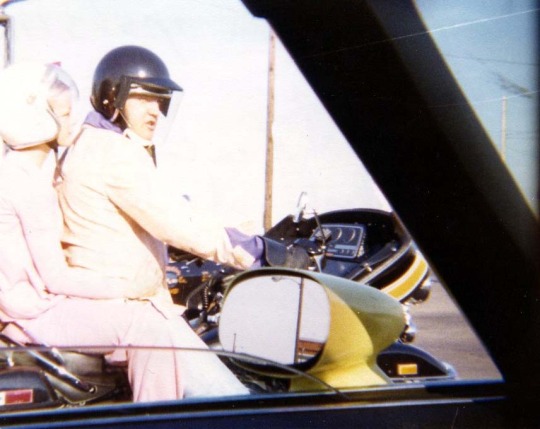
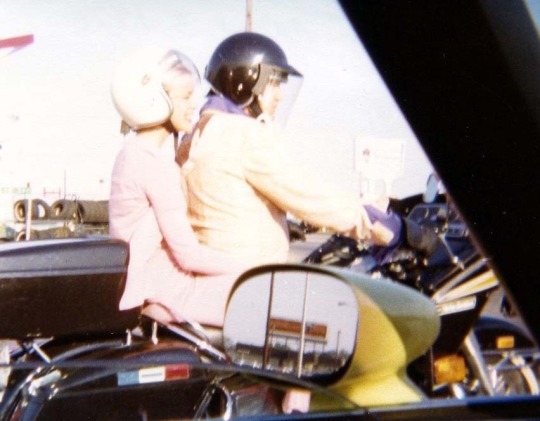
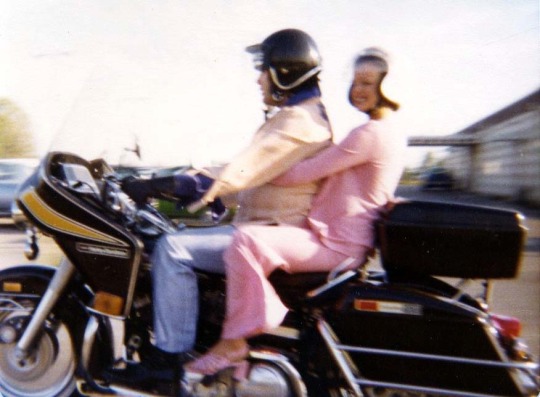
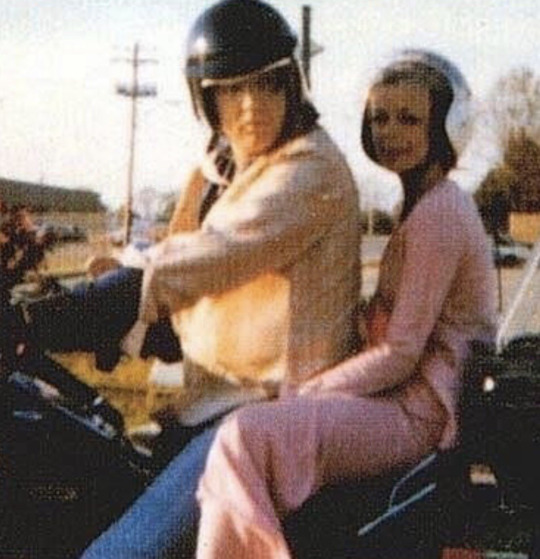
George Klein introduced Tori to Elvis after she participated on his "Talent Party" show. Elvis most likely saw her appearance on the show and asked George to set him up, as he did with Cybill Shepherd and Gail Stanton, who both appeared on "Talent Party" and were immediately asked to be seen by Elvis. This is why many of the MM refer to George Klein as Elvis' pimp 💀, as he was the one responsible for setting Elvis up with women
And like many of the women in Elvis’ life, Tori was involved in beauty queen pageants and held the title of “Miss Ole Miss”. I believe she also occasionally modeled for clothing catalogues while being a student
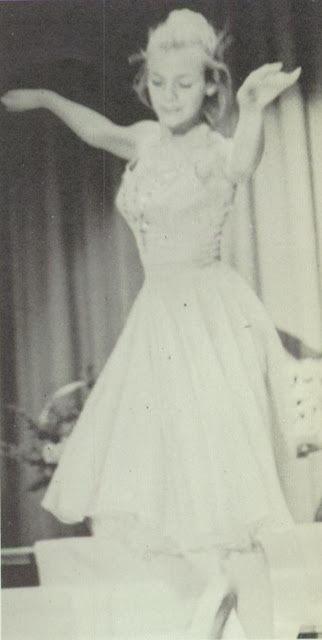
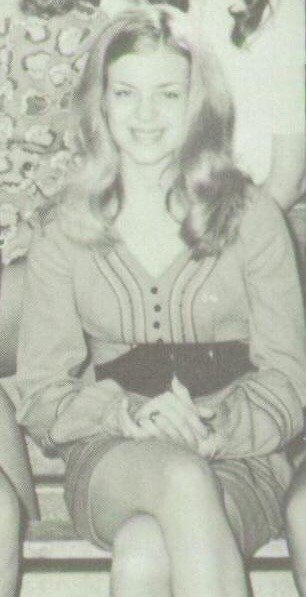
According to George Klein, Elvis began dating Tori while Linda Thompson was staying at the apartment he had leased for her in Los Angeles, California. This goes back to the ask I answered a few days ago regarding Linda and how Elvis would create physical distance between them so he could date other women. Naturally, Linda was upset when she learned about him and Tori 🤧 ⬇️
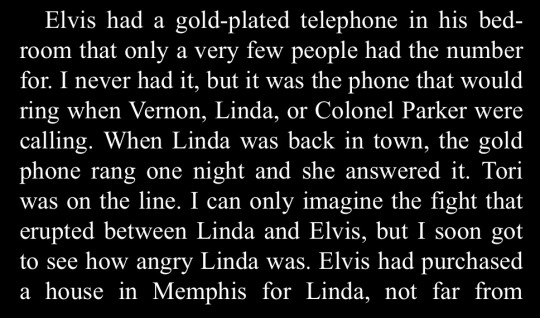
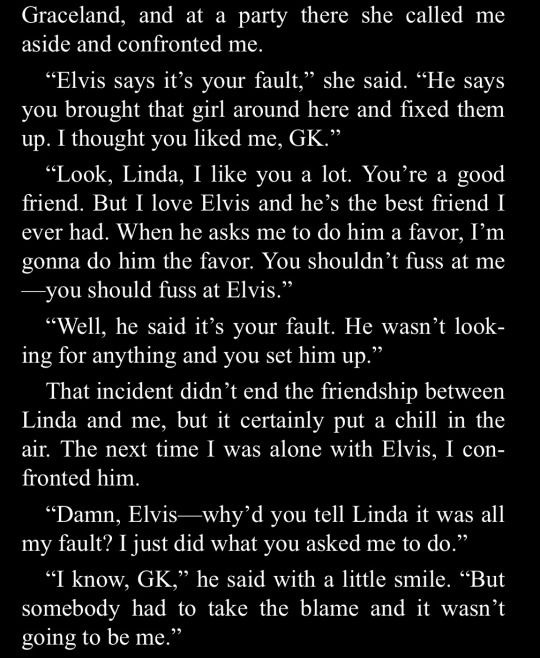
(excerpt from “Elvis: My Best Man” by George Klein)
And, while Tori has never been formally interviewed for a book like "Baby Let's Play House" by Alanna Nash or "Careless Love" by Peter Guralnick, she has openly spoken about Elvis to a few newspapers and may have appeared on a talkshow in the early 1990s ⬇️
Newspaper from August 11, 1994: “Elvis would fly me back and forth from Memphis to Oxford in a little private jet I was certainly impressed," said Petty, now of Dallas. "I wish I could tell you that he was a sweet, down to earth, ordinary man. He was sweet and he was down to earth, but he was extraordinary." One April afternoon, they went for a ride on Elvis' Harley. They were being followed by a woman in a car, who was working on a pictorial book about the star. "At a red light, Elvis said, 'Look at her give her a good picture, and she'll leave us’ So they did. And, it was in focus, from inside a car, with a Kodak Instamatic. The picture appeared in Betty Page's Got Ya, Elvis, I Got ya, published in 1977. Some time after the Memphis ride, an acquaintance told Petty he saw a picture of her with Elvis and put her in touch with the woman who took it. Petty got a print. "It's framed and depending on what else is going on in my life, I either put it in the closet or hang it on the wall." - Interview with Tori Petty
(courtesy of “Clarion-Ledger” on newspapers.com)
As for the possible television appearance, according to this newspaper⬇️, Tori Petty and Gail Stanton ( the playboy model Elvis dated) were interviewed on Geraldo Riveras' talkshow which was set to air on January 8th, 1991 for Elvis’ birthday. I've searched every archive site I know and haven't been able to find the episode 😭 !! In fact, I don't even see the episode listed on Geraldo’s archive which has every season and the names of its’ episodes, so I'm wondering if it ever even aired
Newspaper from December 29, 1990: What would you have to do to wind up being interviewed by Geraldo Rivera? For Memphian Gail Stanton it was nothing deviant or even horrible. That distinction was saved for the interview itself, her grilling by the king of the naughty interview is scheduled to air Jan 8 (10 am on WHBQ-TV). Geraldo was kind of conniving said Ms Stanton ,36, who holds the distinction of being the only Frayser woman who has been a Playboy Playmate of the Month. That was in June 1978 when she followed in the footsteps of Mississippian Stella Stevens with a nude Playboy pose from sea to shining sea. That piqued Geraldo but his real interest was in another distinction. That was Ms Seventies fling with hometown boy Elvis Presley. It was Elvis's Jan 8 birthday that inspired producers to delve once again into the things from drugs to gossipy stepbrothers to girlfriends. The show taped last week included Ms Stanton who was a Shelby County computer programmer before she turned centerfold spread and Tori Petty a former Ole Miss cheerleader who also dated Elvis. Ms Stanton said Geraldo seemed to give short shrift to other guests such as Charles Thompson coauthor of The Death of Elvis spent quite a bit of time- (illegible). Geraldo knows how to turn those questions around, Ms Stanton says, “I think he was trying to get us to say something like whether we'd been to bed with Elvis and of course that's our personal information”. As for Elvis, Ms Stanton volunteers memories such as how he was a Southern gentleman, “There aren't too many men today who open doors for you or are polite and he was. He didn't blast away TV sets in her presence or talk incessantly about mama or even act moody or strange”. She says “He played the piano for me and sang. How many people can say they have been serenaded by Elvis Presley?" - Interview with Gail Stanton
(courtesy of “The Commercial Appeal” on newspapers.com)
And lastly, I found this book that briefly mentions her and the jacket that was given to her by Elvis <3 ⬇️
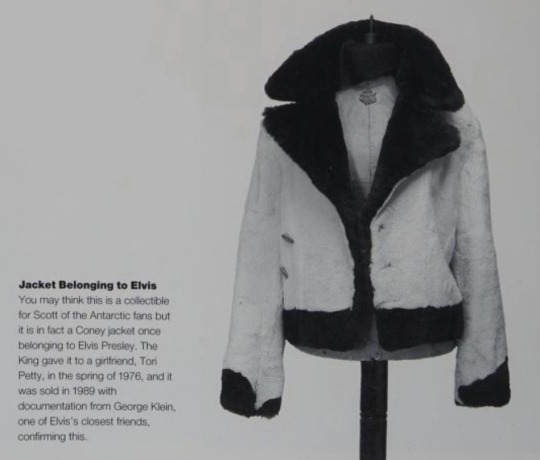
(courtesy of “Rock & Roll Memorabilia” by Hilary Kay)
#if anybody happens to find the Geraldo episode that she is in#I will love you forever !!!#I wish we could have heard more from her 😭#her being dripped out in pink and on the back of Elvis’ motorcycle is so iconic 😩#tori… how did it feel to live my dream ?!#elvis presley#elvisaaronpresley#elvis#tori petty#gail stanton#george klein#linda thompson#big daddy elvis#elvis history#elvis fans#elvis photos#elvis asks#70s#70s elvis
46 notes
·
View notes
Photo

Afternoon TV Stars - May 1976 - David Hasselhoff - The Young and the Restless
#afternoon tv stars#afternoon tv stars may 1976#David Hasselhoff#the young and the restless#Young and the Restless#color photo#soap opera#soap opera history
37 notes
·
View notes
Text
HANS LOVES LUCY
July 10, 1987



By CAROL HOWARD News-Review staff writer
Hans Borger loves Lucy.
Lucille Ball, that is.
The 23-year-old Petoskey man, who wasn't even around for Lucy's golden era during the 1950s, collects books, record albums, videocassette tapes, photos, T-shirts and mugs, all dedicated to his beloved Lucy.
For any cave dwellers out there who may not know of whom we speak, Lucille Ball is one of the best known comediennes in America. Along with her husband, the late Desi Arnaz, the two reigned as queen and king of comedy on their outrageously successful television show, "I Love Lucy," during the 1950s. The show also made stars of Vivian Vance and William Frawley who played Lucy and Desi's landlords, Ethel and Fred Mertz.
After she divorced Arnaz in 1960, Lucy went on to star in her own sitcoms, "The Lucy Show" and "Here's Lucy" in the 1960s and 1970s.
Borger, who is news director at WMBM, a Petoskey radio station, said his love for the zany redhead goes back to his after-school days.
"When I was a kid, I'd come home from school and watch reruns," Borger said. "Shows like "Lucy" and the "Brady Bunch.'"
But he didn't start collecting Florence Henderson memorabilia, he chose Lucy. It must have been the storylines, he said.
"You can watch it (the show) over and over and still find it funny," he said. "Somehow you know everything's going to turn out all right in the end. And you go away with a smile when the show is over. You can't say that with very many other programs."
"The chemistry among the four (actors) was something that made the show the hit that it was," Borger said. "And, as Lucy says, they were lucky.”
Borger turns up his nose at current comedy programs.
"In the 1980s they try and make comedy shows about things like AIDS. That doesn't seem very comical."
Borger also admits, because of Lucy, he loves things from the 1940s and 1950s.
"It kind of influenced my whole way of thinking," he said. "I love the music of (that era). I kind of live in the past."
When Borger has time off, he says he'll kick back and watch an old Lucy episode or one of her game show appearances on his videocassette recorder. It's still a daily routine, he said.
If Borger gets tired of watching Lucy, he can read about her in the Lucy library he has accumulated.
He has a dozen or more books about her life. (She's 75 now). He gets newsletters from the "We Love Lucy" fan club, where he's maintained membership for the past 10 years. He keeps up scrapbooks with Lucy newspaper clippings and magazine articles.
He makes no bones about his devotion: "I could talk about this forever," he said.
He's never met Lucy in person, but he did meet Desi Arnaz near Detroit in 1976 during an autograph session.
"He was signing his autobiography. There he was with a glass of beer and a big, fat cigar," Borger said.
Borger said a controversial topic under discussion among Lucy fans and anyone interested in television history is whether or not the 179 "I Love Lucy" episodes will be colorized. (1)
"I feel it would be great," Borger said. "(I think) if Desi could have filmed them in color, he would have."
Hmmm, that means Lucy's red hair would be red.
There's also an all-points-bulletin out for the "lost" pilot episode of "I Love Lucy," Borger said. Borger's read about it and knows why it's a hot item. (2)
"For one thing, there were no Mertzes," he said. "And it wasn't Ricky and Lucy Ricardo, it was Larry and Lucy Lopez. But they found out there was already a bandleader named Lopez so they had to change the name."
Does Borger have some favorite episodes? "Oh, just like everybody else, I like the Vitameatavegamin show (where Lucy films a commercial for an alcohol-laced tonic until she gets drunk)," Borger said. "And the one called "Sentimental Anniversary" where wind up celebrating their anniversary in their closet. And the one where Lucy tells Ricky she's going to have a baby."
Borger said he plans to keep on collecting all he can about Lucy. "As long as I have the money."
And what if she shows up again on the tube? Will Borger give her another try?
"If she was just standing there, doing nothing, I'd watch it," he said. "If you are a diehard fan, that's just the way it goes."
Lucy and Ricky Lucy Quiz
So you claim to be an "I Love Lucy" fan? Here's a test to just see how much you really know (answers at end of test):
1. What is Lucy Ricardo's maiden name?
2. When Lucy, Ricky, Fred and Ethel go to Hollywood, for whom does Lucy disguise herself with a long, putty nose?
3. Where was Ethel Mertz born? (Hint: it's in New Mexico.)
4. Name the movie Ricky supposedly contracted to film in Hollywood.
5. One day a group called "The Friends of the Friendless" consoled Lucy in a park. Why was Lucy upset?
6. What day of the week does Lucy and Ethel's women's club, the Wednesday Afternoon Fine Arts League, meet?
7. In the famous candy-making episode, what unusual gifts do Ricky and Fred buy their wives after the two women are fired?
8. What musical instrument could Little Ricky play?
9. What is Lucy Ricardo's middle name?
10. What was the plot of the first episode aired?
ANSWERS: 1. MacGillicuddy; 2. William Holden; 3. Albuquerque; 4. Don Juan; 5. No one remembered her birthday; 6. Friday; 7. 5 pound boxes of candy; 8. Drums; 9. Esmeralda; 10. Lucy thinks Ricky is planning to murder her.
From "The ‘I Love Lucy' Quiz Book" by Bart Andrews.
# # #
FOOTNOTES FROM THE FUTURE

(1) In the early 1980s, the Museum of Broadcasting (now the Paley Center for Media) began actively searching for the long-lost “I Love Lucy” pilot. During the 1970s all traces of the pilot had disappeared; not even Desi Arnaz or Lucille Ball owned or knew where to find a copy. In December 1989, a film print was found in the possessions of the late Pepito Perez, who had appeared in the pilot as a clown. Pepito’s widow, Joanne Perez, had read about the search for the pilot in TV Guide and recalled that her husband had been given a copy. CBS aired the pilot as an hour-long special hosted by Lucie Arnaz on Monday (the same day of the week “I Love Lucy” traditionally aired), April 30, 1990. Over 30 million viewers tuned in.

(2) “The ‘I Love Lucy’ Christmas Show” was the first episode CBS aired colorized on December 18, 1989. The ‘wraparound’ segments (the non-flashback parts) were broadcast in the original black and white, but were also colorized starting in 1990. Currently, in addition to the Christmas episode, there are 14 fully-colorized “I Love Lucy” episodes (out of 179):
“Lucy Does A TV Commercial”
“L.A. at Last!”
“Lucy and Superman”
“Job Switching”
“The Million Dollar Idea”
“The Fashion Show”
“Lucy and Harpo Marx”
“Pioneer Women”
“Lucy’s Italian Movie”
“Lucy Visits Grauman’s”
“Lucy Gets Into Pictures”
“Lucy Goes To Scotland”
“Bonus Bucks”
“The Dancing Star”
A DVD was released featuring 11 of the colorized episodes, five of which were screened in movie theatres nationwide prior to the DVD release.
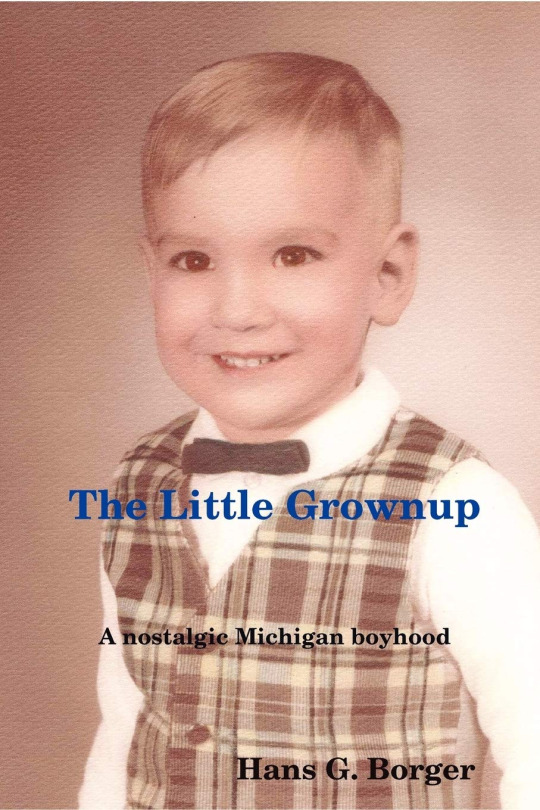
In January 2008, Hans Borger self-published his autobiography “The Little Grownup: A Nostalgic Michigan Boyhood”.
2 notes
·
View notes
Text
Dick Powell: From Musicals to Noir by Susan King
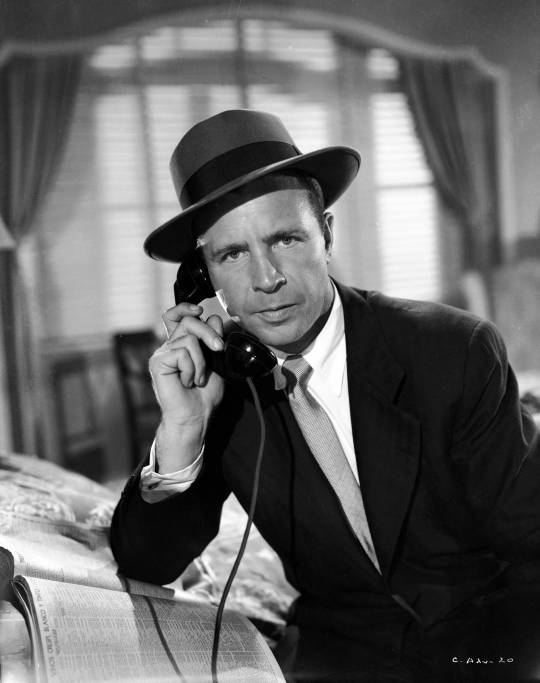
In the fall of 1993, I got the plum assignment to interview Robert Wagner and Stefanie Powers, who were reuniting to make a series of Hart to Hart TV movies for NBC. So, I arrived one late afternoon in Bel-Air where the production was shooting exteriors at a vintage estate that had doubled as the Hart’s house in the original 1979-83 ABC series. The mansion was very Golden Age of Hollywood. The front “yard” was massive and beautifully manicured, and the house was equally impressive. The publicist took me aside to tell me it had been owned by Dick Powell and June Allyson.
The two were one of the power couples in Hollywood from 1945 until Powell’s death at 58 in 1963 (he died the same day as Jack Carson). I immediately remembered the first time I saw the couple in a movie. I was about six and the movie was the 1950 MGM boxing drama RIGHT CROSS, which also starred Ricardo Montalban.
When I was little, I thought Allyson was the bee’s knees. Powell didn’t interest me at all. It wasn’t until I entered USC film school in 1976 that I begin to realize just how good Powell was as an actor. But it took him a long time in his career to show this. He was under contract in the 1930s at Warner Bros., at a time when the moguls kept their stars on a tight leash casting them in roles that were variations of the same theme. Some actors were dutiful and did what they were told; others would turn down the roles and get put on suspension or loaned out to another studio. (Bette Davis actually sued the studio in 1937 to get out of her contract. She lost, but Olivia de Havilland won the battle in 1943.)

Powell became a star as the male ingenue in movies and comedies at Warners, usually romancing Ruby Keeler or his second wife Joan Blondell in such films as 1935’s BROADWAY GONDOLIER. He was cute, had a nice voice and could handle comedy. Very much the fresh-faced boy next door, Powell was the type of guy parents would be thrilled if their daughters dated. And a lot of those early pre-Code musical comedies in which he appeared, such as 1933’s 42nd STREET and 1933’s GOLD DIGGERS OF 1933, are wonderful fun and often subversively surreal thanks to Busby Berkeley’s innovative production numbers.
But, Powell wanted something more and Jack Warner threw him a bone: the lavish and fanciful all-star 1935 adaptation of Shakespeare’s A MIDSUMMER NIGHT’S DREAM, in which Powell plays Lysander who falls in love with the fair Hermia (de Havilland in her film debut). Though I’m sure Laurence Olivier wouldn’t have felt threatened by Powell’s performance, he’s not bad.
However, Powell went back to playing the same kind of ingenue parts in a series of forgettable films. After making 1939’s NAUGHTY BUT NICE with Ann Sheridan, he left Warner Bros. and went to Paramount. His stint at Paramount delivered a mixed bag, save for the delightful 1940 Preston Sturges’ comedy CHRISTMAS IN JULY.

But his career and his life turned upside down in 1944 when he turned 40. He divorced Blondell and fell in love with his MEET THE PEOPLE (’44) co-star Allyson. He also starred in the delightful Rene Clair comedy, IT HAPPENED TOMORROW, in which he played a newspaper man at the turn-of-the-century who magically gets the next day’s paper and he auditioned for the role of Walter Neff in Billy Wilder’s DOUBLE INDEMNITY. Though that role went to Fred MacMurray, another affable Paramount star looking to expand his image, Powell landed the role of world-weary gumshoe Philip Marlowe in RKO’s delicious film noir MURDER, MY SWEET.
Not only did Powell capture the Raymond Chandler character’s cynical sense of humor and smarts, but he looked like someone who had been beaten up one too many times for too little money. And there is a sort of a joy to his performance because he had been set free from playing the boy-next-door types. He was an adult male and along the way he became a noir icon.
Bosley Crowther wrote in the New York Times: “This is a new type of character for Mr. Powell. Though he may lack the steely coldness and cynicism of a Humphrey Bogart, Mr. Powell need not offer any apologies. He has definitely stepped out of the song-and-dance, pretty-boy league with this performance.” And he then made a string of terrific films including 1945’s CORNERED, 1947's JOHNNY O’CLOCK, 1948’s PITFALL, 1951’s CRY DANGER and 1952’s THE BAD AND THE BEAUTIFUL.

He turned to directing in the mid-1950s directing Allyson and Jack Lemmon in YOU CAN’T RUN AWAY FROM IT (‘56), an ill-fated musical version of IT HAPPENED ONE NIGHT (‘34). Powell also directed the well-stuffed 1956 box office turkey THE CONQUERER, with a woefully miscast John Wayne as Genghis Khan. Unfortunately, the film was shot near a former nuclear test site in Utah and numerous people involved in the production—including Powell, Wayne, Susan Hayward, Agnes Moorehead and Pedro Armendariz—all died of cancer.
Powell’s last project was the 1961-1963 anthology series The Dick Powell Show, which he introduced each week and executive produced. The series was changed to The Dick Powell Theater on Jan. 8, 1963, just six days after his death at 58. Guest hosts filled out the rest of the season beginning with Gregory Peck.
UPI TV writer Rick Du Brow wrote that Peck’s brief remarks about Powell’s legacy avoided any “theatricality,” adding that Peck introduced the episode saying: “I’m speaking for a man who was a great and good friend to our industry” and that it was a privilege for the guest hosts to continue the series as “a memorial to Dick Powell.”
102 notes
·
View notes
Text
Sammy Davis, Jr.
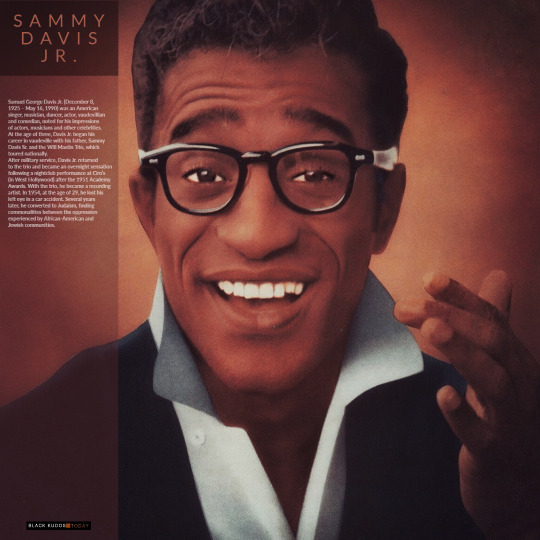
Samuel George Davis Jr. (December 8, 1925 – May 16, 1990) was an American singer, musician, dancer, actor, vaudevillian, comedian, and activist known for his impressions of actors, musicians, and other celebrities. At age three, Davis began his career in vaudeville with his father Sammy Davis Sr. and the Will Mastin Trio, which toured nationally. After military service, he returned to the trio and became an overnight sensation following a nightclub performance at Ciro's (in West Hollywood) after the 1951 Academy Awards. With the trio, he became a recording artist. In 1954, at the age of 29, he lost his left eye in a car accident. Several years later, he converted to Judaism, finding commonalities between the oppression experienced by African-American and Jewish communities.
After a starring role on Broadway in Mr Wonderful (1956), he returned to the stage in 1964's Golden Boy. Davis's film career began as a child in 1933. In 1960, he appeared in the Rat Pack film Ocean's 11. In 1966, he had his own TV variety show, titled The Sammy Davis Jr. Show. While Davis's career slowed in the late 1960s, his biggest hit, "The Candy Man", reached the top of the Billboard Hot 100 in June 1972, and he became a star in Las Vegas, earning him the nickname "Mister Show Business".
Davis had a complex relationship with the black community and drew criticism after publicly supporting President Richard Nixon in 1972. One day on a golf course with Jack Benny, he was asked what his handicap was. "Handicap?" he asked. "Talk about handicap. I'm a one-eyed Negro who's Jewish." This was to become a signature comment, recounted in his autobiography and in many articles.
After reuniting with Frank Sinatra and Dean Martin in 1987, Davis toured with them and Liza Minnelli internationally, before his death in 1990. He died in debt to the Internal Revenue Service, and his estate was the subject of legal battles after the death of his wife. Davis was awarded the Spingarn Medal by the NAACP and was nominated for a Golden Globe Award and an Emmy Award for his television performances. He was a recipient of the Kennedy Center Honors in 1987, and in 2001, he was posthumously awarded the Grammy Lifetime Achievement Award.
Early life
Davis was born on December 8, 1925, in the Harlem section of Manhattan in New York City, the son of African-American entertainer and stage performer Sammy Davis Sr. (1900–1988) and Cuban American tap dancer and stage performer Elvera Sanchez (1905–2000). In the 2003 biography In Black and White, author Wil Haygood wrote that Davis's mother was born in New York City to Afro-Cuban parents. Davis's parents were vaudeville dancers. As an infant, he was reared by his paternal grandmother. When he was three years old, his parents separated. His father, not wanting to lose custody of his son, took him on tour.
Davis learned to dance from his father and his "uncle" Will Mastin. Davis joined the act as a child and they became the Will Mastin Trio. Throughout his career, Davis included the Will Mastin Trio in his billing. Mastin and his father shielded him from racism, such as by explaining race-based snubs as jealousy. However, when Davis served in the United States Army during World War II, he was confronted by strong prejudice. He later said: "Overnight the world looked different. It wasn't one color any more. I could see the protection I'd gotten all my life from my father and Will. I appreciated their loving hope that I'd never need to know about prejudice and hate, but they were wrong. It was as if I'd walked through a swinging door for 18 years, a door which they had always secretly held open." At age seven, Davis played the title role in the film Rufus Jones for President, in which he sang and danced with Ethel Waters. He lived for several years in Boston's South End, and reminisced years later about "hoofing and singing" at Izzy Ort's Bar & Grille.
Military service
During World War II, Davis was drafted into the U.S. Army in 1943 aged 18. He was frequently abused by white soldiers from the South and later recounted that "I must have had a knockdown, drag-out fight every two days." His nose was broken numerous times and permanently flattened. At one point he was offered a beer laced with urine.
He was reassigned to the Army's Special Services branch, which put on performances for troops. At one show he found himself performing in front of soldiers who had previously racially abused him. Davis, who earned the American Campaign Medal and World War II Victory Medal, was discharged in 1945 with the rank of private. He later said, "My talent was the weapon, the power, the way for me to fight. It was the one way I might hope to affect a man's thinking."
Career
After his discharge, Davis rejoined the family dance act, which played at clubs around Portland, Oregon. He also recorded blues songs for Capitol Records in 1949, under the pseudonyms Shorty Muggins and Charlie Green.
On March 23, 1951, the Will Mastin Trio appeared at Ciro's as the opening act for headliner Janis Paige. They were to perform for only 20 minutes but the reaction from the celebrity-filled crowd was so enthusiastic, especially when Davis launched into his impressions, that they performed for nearly an hour, and Paige insisted the order of the show be flipped. Davis began to achieve success on his own and was singled out for praise by critics, releasing several albums.
In 1953, Davis was offered his own television show on ABC, Three for the Road — with the Will Mastin Trio. The network spent $20,000 filming the pilot which presented African Americans as struggling musicians, not slapstick comedy or the stereotypical mammy roles of the time. The cast included Frances Davis who was the first black ballerina to perform for the Paris Opera, actresses Ruth Attaway and Jane White, and Federick O'Neal who founded the American Negro Theater. The network couldn't get a sponsor, so the show was dropped.
In 1954, Davis was hired to sing the title song for the Universal Pictures film Six Bridges to Cross. In 1956, he starred in the Broadway musical Mr. Wonderful.
In 1958, Davis was hired to crown the winner of the Miss Cavalcade of Jazz beauty contest for the famed fourteenth Cavalcade of Jazz concert produced by Leon Hefflin Sr. held at the Shrine Auditorium on August 3. The other headliners were Little Willie John, Sam Cooke, Ernie Freeman, and Bo Rhambo. The event featured the top four prominent disc jockey of Los Angeles.
In 1959, Davis became a member of the Rat Pack, led by his friend Frank Sinatra, which included fellow performers Dean Martin, Joey Bishop, and Peter Lawford, a brother-in-law of John F. Kennedy. Initially, Sinatra called the gathering "the Clan", but Davis voiced his opposition, saying that it reminded people of the Ku Klux Klan. Sinatra renamed the group "the Summit". One long night of poker that went on into the early morning saw the men drunken and disheveled. As Angie Dickinson approached the group, she said, "You all look like a pack of rats." The nickname caught on, and they were called the Rat Pack, the name of its earlier incarnation led by Humphrey Bogart and Lauren Bacall, who originally made the remark of the "pack of rats" about the group around her husband Bogart.
The group around Sinatra made several movies together, including Ocean's 11 (1960), Sergeants 3 (1962), and Robin and the 7 Hoods (1964), and they performed onstage together in Las Vegas.In 1964, Davis was the first African American to sing at the Copacabana night club in New York.
Davis was a headliner at The Frontier Casino in Las Vegas, but, due to Jim Crow practices in Las Vegas, he was required (as were all black performers in the 1950s) to lodge in a rooming house on the west side of the city, instead of in the hotels as his white colleagues did. No dressing rooms were provided for black performers, and they had to wait outside by the swimming pool between acts. Davis and other black artists could entertain but could not stay at the hotels where they performed, gamble in the casinos, or dine or drink in the hotel restaurants and bars. Davis later refused to work at places which practiced racial segregation.
Canada provided opportunities for performers like Davis unable to break the color barrier in U.S. broadcast television, and in 1959, he starred in his own TV special Sammy's Parade on the Canadian network CBC It was a breakthrough event for the performer, as in the United States in the 1950s, corporate sponsors largely controlled the screen: "Black people [were] not portrayed very well on television, if at all," according to Jason King of the Clive Davis Institute of Recorded Music.
In 1964, Davis was starring in Golden Boy at night and shooting his own New York-based afternoon talk show during the day. When he could get a day off from the theater, he recorded songs in the studio, performed at charity events in Chicago, Miami, or Las Vegas, or appeared on television variety specials in Los Angeles. Davis felt he was cheating his family of his company, but he said he was incapable of standing still.
Although he was still popular in Las Vegas, he saw his musical career decline by the late 1960s. He had a No. 11 hit (No. 1 on the Easy Listening singles chart) with "I've Gotta Be Me" in 1969. He signed with Motown to update his sound and appeal to young people. His deal to have his own label with the company fell through. He had an unexpected No. 1 hit with "The Candy Man" with MGM Records in 1972. He did not particularly care for the song and was chagrined that he had become known for it, but Davis made the most of his opportunity and revitalized his career.
Although he enjoyed no more Top 40 hits, he did enjoy popularity with his 1976 performance of the theme song from the Baretta television series, "Baretta's Theme (Keep Your Eye on the Sparrow)" (1975–1978), which was released as a single (20th Century Records). He appeared on the television shows The Rifleman, I Dream of Jeannie, All in the Family (during which he famously kisses Archie Bunker (Carroll O'Connor) on the cheek), and Charlie's Angels (with his wife, Altovise Davis). He appeared in Japanese commercials for Suntory whisky in the 1970s.
On December 11, 1967, NBC broadcast a musical-variety special featuring Nancy Sinatra, daughter of Frank Sinatra, titled Movin' with Nancy. In addition to the Emmy Award-winning musical performances, the show is notable for Nancy Sinatra and Davis greeting each other with a kiss, one of the first black-white kisses in US television.
Davis had a friendship with Elvis Presley in the late 1960s, as they both were top-draw acts in Vegas at the same time. Davis was in many ways just as reclusive during his hotel gigs as Elvis was, holding parties mainly in his penthouse suite which Elvis occasionally attended. Davis sang a version of Presley's song "In the Ghetto" and made a cameo appearance in Presley's concert film Elvis: That's the Way It Is. One year later, he made a cameo appearance in the James Bond film Diamonds Are Forever, but the scene was cut. In Japan, Davis appeared in television commercials for coffee, and in the United States he joined Sinatra and Martin in a radio commercial for a Chicago car dealership.
On May 27–28, 1973, Davis hosted (with Monty Hall) the first annual, 20-hour Highway Safety Foundation telethon. Guests included Muhammad Ali, Paul Anka, Jack Barry, Dr. Joyce Brothers, Ray Charles, Dick Clark, Roy Clark, Howard Cosell, Ossie Davis, Ruby Dee, Joe Franklin, Cliff Gorman, Richie Havens, Danny Kaye, Jerry Lewis, Hal Linden, Rich Little, Butterfly McQueen, Minnie Pearl, Boots Randolph, Tex Ritter, Phil Rizzuto, The Rockettes, Nipsey Russell, Sally Struthers, Mel Tillis, Ben Vereen, and Lawrence Welk. It was a financial disaster. The total amount of pledges was $1.2 million. Actual pledges received were $525,000.
Davis was a huge fan of daytime television, particularly the soap operas produced by the American Broadcasting Company. He made a cameo appearance on General Hospital and had a recurring role as Chip Warren on One Life to Live, for which he received a 1980 Daytime Emmy Award nomination. He was also a game show fan, appearing on Family Feud in 1979 and Tattletales with his wife Altovise in the 1970s.
After his bout with cirrhosis due to years of drinking, Davis announced his sponsorship of the Sammy Davis Jr. National Liver Institute in Newark, New Jersey in 1985. In 1988, Davis was billed to tour with Frank Sinatra and Dean Martin, but Sinatra and Martin had a falling out. Liza Minnelli replaced Dean on the tour dubbed as ''The Ultimate Event.'' During the tour in 1989, Davis was diagnosed with throat cancer; his treatments prevented him from performing.
Personal life
Accident and conversion
Davis nearly died in an automobile accident on November 19, 1954, in San Bernardino, California, as he was making a return trip from Las Vegas to Los Angeles. During the previous year, he had started a friendship with comedian and host Eddie Cantor, who had given him a mezuzah. Instead of putting it by his door as a traditional blessing, Davis wore it around his neck for good luck. The only time he forgot it was the night of the accident. The accident occurred at a fork in U.S. Route 66 at Cajon Boulevard and Kendall Drive. Davis lost his left eye to the bullet-shaped horn button (a standard feature in 1954 and 1955 Cadillacs) as a result. His friend, actor Jeff Chandler, said he would give one of his own eyes if it would keep Davis from total blindness. Davis wore an eye patch for at least six months following the accident. He was featured with the patch on the cover of his debut album and appeared on What's My Line? wearing the patch. Later, he was fitted for a glass eye, which he wore for the rest of his life.
Eddie Cantor talked to Davis in the hospital about the similarities between the Jewish and black cultures. Davis, who was born to a Catholic mother and Baptist father, began studying the history of Jews. He converted to Judaism several years later in 1961. One passage from his readings (from the book A History of the Jews by Abram L. Sachar), describing the endurance of the Jewish people, interested him in particular: "The Jews would not die. Three millennia of prophetic teaching had given them an unwavering spirit of resignation and had created in them a will to live which no disaster could crush." The accident marked a turning point in Davis's career, taking him from a well-known entertainer to a national celebrity.
Marriages
In 1957, Davis was involved with actress Kim Novak, who was under contract with Columbia Pictures. Because Novak was white, Harry Cohn, the president of Columbia, gave in to his worries that racist backlash against the relationship could hurt the studio. There are several accounts of what happened, but they agree that Davis was threatened by organized crime figures close to Cohn. According to one account, Cohn called racketeer John Roselli, who was told to inform Davis that he must stop seeing Novak. To try to scare Davis, Roselli had him kidnapped for a few hours. Another account relates that the threat was conveyed to Davis's father by mobster Mickey Cohen. Davis was threatened with the loss of his other eye or a broken leg if he did not marry a black woman within two days. Davis sought the protection of Chicago mobster Sam Giancana, who said that he could protect him in Chicago and Las Vegas but not California.
Davis briefly married black dancer Loray White in 1958 to protect himself from mob violence; Davis had previously dated White, who was 23, twice divorced and had a six-year-old child. He paid her a lump sum, $10,000 or $25,000, to engage in a marriage on the condition that it would be dissolved before the end of the year. Davis became inebriated at the wedding and attempted to strangle White en route to their wedding suite. Checking on him later, Silber found Davis with a gun to his head. Davis despairingly said to Silber, "Why won't they let me live my life?" The couple never lived together, and commenced divorce proceedings in September 1958. The divorce was granted in April 1959.
In 1960, there was another racially charged public controversy when Davis married white, Swedish-born actress May Britt in a ceremony officiated by Rabbi William M. Kramer at Temple Israel of Hollywood. While interracial marriage had been legal in California since 1948, anti-miscegenation laws in the United States still stood in 23 states, and a 1958 opinion poll had found that only 4 percent of Americans supported marriage between black and white spouses. Davis received racist hate mail while starring in the Broadway adaptation of Golden Boy during 1964–1966, in which his character is in a relationship with a white woman, paralleling his own interracial relationship. At the time Davis appeared in the musical, although New York had no laws against it, debate about interracial marriage was still ongoing in America as Loving v. Virginia was being fought. It was only in 1967, after the musical had closed, that anti-miscegenation laws in all states were ruled unconstitutional by the Supreme Court of the United States.
Davis's daughter Tracey Davis revealed in a 2014 book that this marriage also resulted in President Kennedy refusing to allow Davis to perform at his Inauguration. The snub was confirmed by director Sam Pollard, who revealed in a 2017 American Masters documentary that Davis's invitation to perform at his inauguration was abruptly canceled on the night of his inaugural party.
Davis and Britt had one daughter, Tracey, and adopted two sons, Mark and Jeff. Davis performed almost continuously and spent little time with his wife. They divorced in 1968, after Davis admitted to having had an affair with singer Lola Falana. After his marriage imploded, Davis turned to alcohol and "found solace in drugs, particularly cocaine and amyl nitrite, and experimented briefly with Satanism and pornography."
In 1968, Davis started dating Altovise Gore, a dancer in Golden Boy. They were married on May 11, 1970, by the Reverend Jesse Jackson. Kathy McKee replaced Gore in Davis's nightclub act. They adopted a son, Manny, in 1989. Davis and Gore remained married until his death in 1990.
Hobbies
Davis was an avid photographer who enjoyed shooting pictures of family and acquaintances. His body of work was detailed in a 2007 book by Burt Boyar titled Photo by Sammy Davis, Jr. "Jerry [Lewis] gave me my first important camera, my first 35 millimeter, during the Ciro's period, early '50s," Boyar quotes Davis. "And he hooked me." Davis used a medium format camera later on to capture images. Boyar reports that Davis had said, "Nobody interrupts a man taking a picture to ask ... 'What's that nigger doin' here?'" His catalog includes rare photos of his father dancing onstage as part of the Will Mastin Trio and intimate snapshots of close friends Jerry Lewis, Dean Martin, Frank Sinatra, James Dean, Nat "King" Cole, and Marilyn Monroe. His political affiliations also were represented, in his images of Robert Kennedy, Jackie Kennedy, and Martin Luther King Jr. His most revealing work comes in photographs of wife May Britt and their three children, Tracey, Jeff and Mark.
Davis was an enthusiastic shooter and gun owner. He participated in fast-draw competitions. Johnny Cash recalled that Davis was said to be capable of drawing and firing a Colt Single Action Army revolver in less than a quarter of a second. Davis was skilled at fast and fancy gunspinning and appeared on television variety shows showing off this skill. He also demonstrated gunspinning to Mark on The Rifleman in "Two Ounces of Tin." He appeared in Western films and as a guest star on several television Westerns.
Political beliefs
Davis was a registered Democrat and supported John F. Kennedy's 1960 election campaign as well as Robert F. Kennedy's 1968 campaign. John F. Kennedy would later refuse to allow Davis to perform at his inauguration on account of his marriage with the white actress May Britt. Nancy Sinatra revealed in her 1986 book Frank Sinatra: My Father how Kennedy had planned to snub Davis as plans for his wedding to Britt were unfolding. He went on to become a close friend of President Richard Nixon and publicly endorsed him at the 1972 Republican National Convention. Davis also made a USO tour to South Vietnam at Nixon's request.
In February 1972, during the later stages of the Vietnam War, Davis went to Vietnam to observe military drug abuse rehabilitation programs and talk to and entertain the troops. He did this as a representative from President Nixon's Special Action Office For Drug Abuse Prevention. He performed shows for up to 15,000 troops; after one two-hour performance he reportedly said "I've never been so tired and felt so good in my life." The U.S. Army made a documentary about Davis's time in Vietnam performing for troops on behalf of Nixon's drug treatment program.
Nixon invited Davis and his wife, Altovise, to sleep in the White House in 1973, the first time African-Americans were invited to do so. The Davises spent the night in the Lincoln Bedroom. Davis later said he regretted supporting Nixon, accusing Nixon of making promises on civil rights that he did not keep. Davis was a long-time donor to the Reverend Jesse Jackson's Operation PUSH organization.
Illness and death
In August 1989, Davis began to develop symptoms—a tickle in his throat and an inability to taste food. Doctors found a cancerous tumor in Davis's throat. He had often smoked four packs of cigarettes a day as an adult. When told that surgery (laryngectomy) offered him the best chance of survival, Davis replied he would rather keep his voice than have a part of his throat removed; he was initially treated with a combination of chemotherapy and radiation. His larynx was later removed when his cancer recurred. He was released from the hospital on March 13, 1990.
Davis died of complications from throat cancer two months later at his home in Beverly Hills, California, on May 16, 1990, aged 64. He was interred in Forest Lawn Memorial Park in Glendale, California. On May 18, 1990, two days after his death, the neon lights of the Las Vegas Strip were darkened for ten minutes as a tribute.
Estate
Davis left a bulk of his estate, estimated at $4 million, to his widow Altovise Davis, but he owed the IRS $5.2 million which due to interest and penalties had increased to over $7 million. His widow Altovise Davis became liable for his debt because she had cosigned his tax returns. She was forced to auction his personal possessions and real estate. Some of his friends in the industry, including Quincy Jones, Joey Bishop, Ed Asner, Jayne Meadows and Steve Allen, participated in a fundraising concert at the Sands Hotel in Las Vegas. Altovise Davis and the IRS reached a settlement in 1997. After she died in 2009, their son Manny was named executor of the estate and majority rights holder of his intellectual property.
Legacy
On June 25, 2019, The New York Times Magazine listed Davis among hundreds of artists whose material was reportedly destroyed in the 2008 Universal fire.
Portrayals
In an episode of Charlie's Angels, Davis had a dual role, playing both himself and as a Sammy Davis Jr. impersonator who is kidnapped by mistake. (In a comic relief scene the impersonator beats up a candy machine which does not give him his candy, a spoof of Davis's song "The Candy Man".)
Comedian Jim Carrey has portrayed Davis on stage, in the 1983 film Copper Mountain, and in a stand-up routine.
On Saturday Night Live, Davis has been portrayed by Garrett Morris, Eddie Murphy, Billy Crystal and Tim Meadows.
Davis was portrayed on the popular sketch comedy show In Living Color by Tommy Davidson, notably a parody of the film Ghost, in which the ghost of Davis enlists the help of Whoopi Goldberg to communicate with his wife.
David Raynr portrayed Davis in the 1992 miniseries Sinatra, a television film about the life of Frank Sinatra.
In the comedy film Wayne's World 2 (1993), Tim Meadows portrays Davis in the dream sequence with Michael A. Nickles as Jim Morrison.
In the sitcom Malcolm & Eddie (1996), Eddie Sherman (played by comedian Eddie Griffin) impersonates Davis in the episode "Sh-Boing-Boing" to help his partner Malcolm McGee (played by Malcolm-Jamal Warner) reconcile his grandparents' relationship.
Davis was portrayed by Don Cheadle in the HBO film The Rat Pack, a 1998 television film about the group of entertainers. Cheadle won a Golden Globe Award for his performance.
He was portrayed by Paul Sharma in the 2003 West End production Rat Pack Confidential.
Davis was portrayed in 2008 by Keith Powell in an episode of 30 Rock titled "Subway Hero."
In September 2009, the musical Sammy: Once in a Lifetime premiered at the Old Globe Theatre in San Diego with book, music, and lyrics by Leslie Bricusse, and additional songs by Bricusse and Anthony Newley. The title role was played by Tony Award nominee Obba Babatundé.
Comedian Billy Crystal has portrayed Davis on "Saturday Night Live," in his stand-up routines, and at the 2012 Oscars.
Actor Phaldut Sharma created the comedy web-series I Gotta Be Me (2015), following a frustrated soap star as he performs as Sammy in a Rat Pack tribute show.
In January 2017, Davis's estate joined a production team led by Lionel Richie, Lorenzo di Bonaventura, and Mike Menchel to make a movie based on Davis's life and show-biz career.
Honors and awards
Shortly before his death in 1990, ABC aired the TV special Sammy Davis, Jr. 60th Anniversary Celebration. An all-star cast, including Michael Jackson, Eddie Murphy, Diahann Carroll, Clint Eastwood, and Ella Fitzgerald, paid tribute to Davis. The show was nominated for six Primetime Emmy Awards, winning Outstanding Variety, Music or Comedy.
Grammy AwardsEmmy AwardsOther honors
Discography
Filmography
Stage
Mr. Wonderful (1957), musical
Golden Boy (1964), musical – Tony Nomination for Best Actor in a Musical
Sammy (1974), special performance featuring Davis with the Nicholas Brothers
Stop the World – I Want to Get Off (1978) musical revival
Television
General Electric Theater – "The Patsy" (1960) Season 8 Episode 21
Lawman – episode Blue Boss and Willie Shay" (1961)
The Dick Powell Show – episode "The Legend" (1962)
Hennesey – episode "Tight Quarters" (1962)
The Rifleman – 2 episodes "Two Ounces of Tin (#4.21)" (February 19, 1962) and "The Most Amazing Man (#5.9)" (November 27, 1962)
77 Sunset Strip – episode "The Gang's All Here" (1962)
Ben Casey – episode "Allie" (1963)
The Patty Duke Show – episode "Will the Real Sammy Davis Please Hang Up?" (1965)
The Sammy Davis Jr. Show – Host (January 7, 1966)
Alice In Wonderland or What's a Nice Kid Like You Doing in a Place Like This? (March 30, 1966)
The Wild Wild West – episode "The Night of the Returning Dead" (October 14, 1966)
Batman – "The Clock King's Crazy Crimes" (1966)
I Dream of Jeannie – episode "The Greatest Entertainer in the World" (1967)
Rowan & Martin's Laugh-In – Here Comes The Judge skit (1968–70, 1971, 1973)
The Mod Squad – three episodes: "Keep the Faith Baby" (1969), "Survival House" (1970), and "The Song of Willie" (1970)
The Beverly Hillbillies – episode Manhattan Hillbilies (1969)
The Name of the Game – episode "I Love You, Billy Baker" (1970)
Here's Lucy (1970)
All in the Family – episode "Sammy's Visit" (1972)
Chico and the Man – episode "Sammy Stops In" (1975)
The Carol Burnett Show (1975)
Sammy and Company – host/performer (1975-1977)
Charlie's Angels – episode "Sammy Davis, Jr. Kidnap Caper" (1977)
Sanford (TV series) – episodes "Dinner and George's" (cameo) and "The Benefit" (1980)
Archie Bunker's Place – episode "The Return of Sammy" (1980)
General Hospital – episode Benefit for Sports Center (1982)
Channel Seven Perth's Telethon (1983)
The Jeffersons – episode "What Makes Sammy Run?" (1984)
Fantasy Island – episode "Mr. Bojangles and the Dancer/Deuces are Wild" (1984)
Gimme a Break! – episode "The Lookalike" (1985)
Alice in Wonderland (1985 film)
Hunter – episode "Ring of Honor" (1989)
The Cosby Show – episode "No Way, Baby" (1989)
Sammy Davis, Jr. 60th Anniversary Celebration (1990) – 2½ hour all star TV special
10 notes
·
View notes
Text
"ONCE UPON A TIME . . . IN HOLLYWOOD" (2019) Review

"ONCE UPON A TIME . . . IN HOLLYWOOD" (2019) Review When I had first learned that producer-director Quentin Tarantino had plans to make a movie about "Old Hollywood", I assumed that it would be set during the early 20th century - at least sometime between the 1920s and the 1940s. I had no idea that the movie would be set near the end of the 1960s.
The reason behind my initial assumption was that I have never considered the 1960s decade to be a part of . . . "Old Hollywood". For me, that era in film history had ended by the late 1950s. I eventually learned that a good number of movie stars - Rock Hudson being one of them - had retained contracts with the industries movie studios even during the Sixties. Even those who had transferred from movie to television productions. Then . . . I heard that the movie would be about the LaBianca-Tate Murders from August 1969. Familiar with the level of violence featured in past Tarantino movies, I was pretty determined to avoid this movie. I am used to the violence featured in the director's past movies. But I really could not see myself sitting in a movie theater and watching a re-creation of the murder of actress Sharon Tate, Hollywood hairdresser Jay Sebring and a few other friends at the hands of Charles Manson's Family. I had seen the 1976 movie, "HELTER SKELTER" when I was a kid. Once was enough and that was only a two-part television movie. But when I had eventually learned that "ONCE UPON A TIME . . . IN HOLLYWOOD" was a revisionist movie like his 2009 film, "INGLORIOUS BASTERDS", I decided to give it a chance. "ONCE UPON A TIME . . . IN HOLLYWOOD" covered a six month period near the end of the 1960s - from February to August 1969. To be honest, the movie is divided into two time periods. Two-thirds of the movie is set during a 36-hour period in early Februrary 1969. The last third of the film is set during the afternoon and evening hours of August 8-9, 1969. The movie is about the experiences of two men - Hollywood television actor Rick Dalton and his friend/stunt man/chauffeur Cliff Booth. Following the cancellation of his television series, "Bounty Law", Rick had been making guest appearances in various television shows as villains. Casting agent Marvin Schwarz warns Rick that the longer he continues appearing in television episodes as the villain, his career will eventually die and no one will remember him from "Bounty Law". The agent suggests that Rick consider going to Europe to star in an Italian western or two. And Cliff find his career as a Hollywood stuntman over due to rumors that he may have killed his wife and an altercation with Bruce Lee on the set of "THE GREEN HORNET". Only his job as Rick's chauffeur/handyman has allowed Cliff to earn any cash, thanks to the actor's alcoholism and collection of DUIs that led to the removal his driver's license. Rick has also acquired new neighbors - Polish-born director Roman Polanski and his actress wife Sharon Tate - both with Hollywood careers that seemed to be on the upswing. The couple had just began leasing the home of music producer Terry Melcher. Rick has dreams of befriending them as a means to revive his career. Meanwhile, he contemplates accepting Marvin's suggestion, while he begins work on his current job - a guest appearance as another villain in the pilot episode of the TV western called "LANCER". As for Cliff, he becomes acquainted with a beautiful hitchhiker named Pussycat. She turns out to be a member of the Manson Family, who are staying at Spahn Ranch, where he and Rick used to film "Bounty Law". Cliff's encounter with the ranch's owner, the blind and aging George Spahn and members of the Manson Family foreshadows a later encounter on that infamous night, six months later. While contemplating his career, I noticed all of the four movies made by Quentin Tarantino in the past ten years were period pieces. All of them . . . from "INGLORIOUS BASTERDS" to this current film, "ONCE UPON A TIME . . . IN HOLLYWOOD". I would never consider the other three films as nostalgic, but a part of me cannot help but wonder if I could say the same about this latest one. The pacing for "ONCE UPON A TIME . . . IN HOLLYWOOD" struck me as a lot more detailed, relaxed and reflective than any of his previous movies. It almost seemed as if Tarantino was paying some kind of loving tribute to the end of the old Hollywood studio system. For me, this seemed like both a good thing and a bad one. Tarantino always had a reputation for scenes that featured long stretches of dialogue or detailed action sequences. And yes, the pacing in his films - with the exception of scenes featuring action or revelations of previous mysteries - can be a tad slow upon first viewing. But "ONCE UPON A TIME . . . IN HOLLYWOOD" marked the first time I can recall such a small amount of violence or action. Tarantino seemed more evoking a sense of the past than in any other of his period films. For "ONCE UPON A TIME . . . IN HOLLYWOOD", it was a good thing for the film managed to permeate the end of the 1960s in Los Angeles and the Hollywood Studio system thanks to Tarantino's direction, Barbara Ling's superb production designs, Arianne Phillips' costume designs and the art direction led by Richard L. Johnson. On the other hand, Tarantino's in-depth peek into Los Angeles 1969 also had a negative impact . . . a minor one, if I must be honest. This slow exploration also included a look into actress Sharon Tate's life . . . at least in the first two-thirds of the film. Basically, the movie reflected a peek into the daily life of the actress - attending a party at Hugh Hefner's Playboy mansion, visiting a bookstore in the Westwood Village, and watching her latest film ("THE WRECKING CREW") at the theater. I realize that Tarantino was trying to pay some kind of homage to Tate, but I found this . . . homage rather dragged the film's pacing. There were two other aspects of "ONCE UPON A TIME . . . IN HOLLYWOOD" that I found troubling. One brief scene early in the film featured an appearance by Charles Manson at the Polanski-Tate home, searching for music producer Terry Melcher, who owned it. In real life, Manson had visited the house on several occasions, searching for the music producer. These visits had led to the Tate-LaBianca murders. But the movie only featured one visit by Manson and it happened early in the film . . . six months before the night of August 8-9. I believe this is where Tarantino's narrative structure for the film had failed. I belief the film's second act, which is set during that very night, should have began at least a few days or a week or two earlier, allowing one or two more visits by Manson to 10050 Cielo Drive and setting up his plan to send some of his followers to kill its inhabitants. And there was Cliff's infamous fight with Bruce Lee that outraged a good number of critics and moviegoers and led them to accuse Tarantino of disrespct toward the actor/martial artist and racism. Many took umbrage at Tarantino's portrayal of Lee as a braggadocio who needed to be taken down by a white man in a fight - namely Cliff. If I must honest, I felt the same. I still do . . . somewhat. I recently discovered that one of the production companies backing the film is Bona Film Group, a Chinese organization controlled by Yu Dong and Jeffrey Chan. As producers and co-financiers of the film, why did Bona Film Group fail to protest against the Booth-Lee encounter? Did the company's executives have a personal grudge against the late martial artist? Was this lack of protest due to some unpopularity of Lee in mainland China? Or did the production company simply not cared? One minor nitpick . . . actor Mike Moh's hairstyle for Lee was a bit too long for that 1966 or 1967 flashback. Personally, I think Tarantino should have never added that scene in the first place. It was not that relevant to the film's overall narrative. Or he could have easily allowed Cliff to have a fight with a fictional character, instead of Lee . . . anything to avoid the unnecessary controversy that followed. Despite these flaws, I really enjoyed "ONCE UPON A TIME . . . IN HOLLYWOOD". As I had stated earlier, I really enjoyed the film's atmospheric setting of the Hollywood community at the end of the 1960s. The movie also did an excellent job in conveying Tarantino's talent for creating a narrative structure for his films. The director allowed moviegoers a peak into a Hollywood industry that was in the process of change from the old studio system to the industry's American New Wave era between the mid-1960s and the early 1980s. This transistion was conveyed in the film not only marked by Rick Dalton's anxiety over his foundering career, but also capped by the Manson Family's attack upon Cielo Drive. However, Rick was not the only one anxious about his future. Cliff Booth faced professional oblivion following Rick's marriage to an Italian actress in the film's second half. Despite their close relationship, Rick made it obvious that he could not afford to keep Cliff in his employ. The night of August 8-9 was supposed to be his last night in Rick's employ. What is also interesting about this film is that like "THE HATEFUL EIGHT", it ended on an ambiguous note. Was Rick's career ever salvaged? Also, many have forgotten that on the following evening, Charles Manson himself led a second attack upon Leno and Rosemary LaBianca in Los Angeles' Los Feliz neighborhood. Did the revisionist ending of "ONCE UPON A TIME . . . IN HOLLYWOOD" prevent these murders? I wonder. The movie also featured many sequences that I found very enjoyable to watch. They also help set up and maintain the film's narrative. These scenes included Marvin Schwarz's frank assessment of Rick's career, Polanski and Tate's appearance at a Playboy Mansion party, Rick's delightful interactions with an eight year-old actress named Trudi Fraser on the "LANCER" set that helped him turn in a memorable performance, Rick's breakdown in a trailer after flubbing his lines, and Cliff's meeting with Pussycat. But there were two scenes that really stood out for me. One of those scenes were Cliff's encounter with the Manson family at Spahn's Ranch seemed like Tarantino's take on what happened between "the family" and a stuntman named Donald Shea in late August 1969. I thought Tarantino did a superb job with this scene. It was well-paced, filled with a great deal of tension. I can say the same about the movie's last sequence that featured the Manson Family's attack upon Cielo Drive during the night of August 8-9. This is where Tarantino' use of historical revision came into play. The director-writer used Rick's constant complaints about "hippies", his celebrity as a former television star and Cliff's previous encounter with the Manson Family to re-direct the latter's attack from the Polanski-Tate household to the Dalton household. And what unfolded was chaotic, occasionally funny and yes, very scary. It truly was a well shot and well-acted sequence. "ONCE UPON A TIME . . . IN HOLLYWOOD" featured a good deal of cameos - probably a lot more than any previous Tarantino film (I could be wrong, since I have not seen all of his films). Making solid cameos were Damian Lewis, Michael Madsen, Timothy Olyphant (as actor James Stacy), Luke Perry (as actor Wayne Maunder), Damon Herriman (as Charles Manson), Ramón Franco, Lena Durnham, Rumer Willis, Martin Kove, Clu Galagher, Rebecca Gayheart, Brenda Vaccaro, Scoot McNairy, Clifton Collins, Jr., James Remar, and Toni Basil. The movie also featured some very memorable supporting performances - especially from the likes of Al Pacino, who delightfully portrayed casting agent Marvin Schwarz; an entertaining Kurt Russell who not only portrayed stunt gaffer Randy Miller, but also served as the film's narrator; Zoë Bell, who was equally entertaining as Randy's stunt gaffer wife Janet; Mike Moh, who gave a colorful performance as Bruce Lee; Lorenza Izzo, as Rick's wife Francesca Capucci; a rather frightening Dakota Fanning as Lynette "Squeaky" Fromme, Manson family member; Maya Hawke as "Flower Child"; Nicholas Hammond as actor-director Sam Wanamaker; Rafał Zawierucha as Roman Polanski; Julia Butters as the delightful child actor Trudi Fraser; a very charming Emile Hirsch as Jay Sebring; the always entertaining Bruce Dern as George Spahn; and Margaret Qualley, who was very memorable as Manson Family member "Pussycat". I will be the first admit that Tarantino made little use of Sharon Tate in this film. It was quite clear that her presence really served as a catalyst for Tarantino's story and possibly a muse. But I cannot deny that Margot Robbie gave a very charming and ellubient performance as the late actress. Brad Pitt, on the other hand, gave a very subtle yet memorable performance as former stuntman Cliff Booth, whose career had seen better days. This was due to the mysterious circumstances behind the death of Cliff's wife. Many believe he may have killed her and got away with the crime. And Pitt managed to reflect this ambiguity in his performance and in his eyes. There were times when it seemed there was a bit of a "cool superhero" element in the character that at times, made it a bit difficult for me to relate to him. But thanks to Pitt's natural screen persona and a very subtle performance, I was able to do so in the end. If I had to choose the most complex character in the entire movie, it would have to be former television star Rick Dalton. And I cannot deny that Leonardo DiCaprio did an exceptional job of conveying this character to the movie screen. Thanks to DiCaprio's performance and Tarantino, Rick is such a conumdrum. One could label him as one of those actors from the late 1950s and early 1960s, who became television stars and later tried to make the transition to film. I have read many comments that Rick has a conservative outlook on his tastes and acting skills that will forever limit him from becoming a star in Hollywood's New Age in films. This is very apparent in Rick's pompadour hairstyle in the film's first half, his occasional rants against hippies and his reluctant to adapt to the new Hollywood. And yet . . . Rick eventually concedes to Schwarz's suggestion that he try Italian westerns, he changes his hairstyle and wardrobe to reflect the fashions of the late 1960s and early 1970s, and he seeks to make social connections with Polanski and Tate to further his career. Rick is also an alcoholic and might be bipolar. DiCaprio did an excellent job in conveying Rick's emotional state that reflect these traits. "ONCE UPON A TIME . . . IN HOLLYWOOD" is not my favorite Quentin Tarantino film, it has became my favorite film of 2019. I do not think it has a chance of winning any of the big prizes during the awards season of 2019-2020. I have a deep suspicion that the media and the Hollywood community is not as enamoured of it as I am. Which is okay . . . to each his or her own. But damn it, the movie was superb. I have heard rumors that Tarantino plans to retire from filmmaking. Personally, I think this is a mistake on his part. Perhaps he wants to end his career on a high note. And "ONCE UPON A TIME . . . IN HOLLYWOOD" is certainly a reflection of it, thanks to Tarantino's direction, his screenplay, the movie's production values and especially the cast led by Leonardo DiCaprio and Brad Pitt. But I hope that Tarantino continues to make movies.

#quentin tarantino#once upon a time in hollywood#leonardo dicaprio#brad pitt#la bianca-tate murders#manson family#american new wave#margot robbie#margaret qualley#sharon tate#roman polanski#george spahn#spahn ranch#cielo drive#bruce dern#dakota fanning#eamon farren#al pacino#emile hirsch#timothy olyphant#lancer#maya hawke#austin butler#julia butters#nicholas hammond#mike moh#bruce lee#damian lewis#rumer willis#luke perry
12 notes
·
View notes
Photo

NOVIDADES DE STAR TREK: STRANGE NEW WORLDS...!! A engenharia da USS Enterprise do Capitão Pike já tem uma nova pessoa responsável. Desta vez teremos uma engenheira e humana! A atriz e comediante Carol Kane que já teve indicações ao Oscar, participou de filmes conhecidos como "Um Dia de Cão" (Dog Day Afternoon - 1976), "Noivo Neurótico, Noiva Nervosa" (Annie Hall - 1977), "Muppets - O Filme" (The Muppet Movie - 1979), "The Princess Bride" (A Princesa Prometida - 1987) e mais uma dezena de outros filmes e séries de TV diversas, será a nova personagem recorrente em Star Trek: Strange New Worlds (SNW) nesta temporada. Ela interpretará Pelia (único nome até o momento), uma engenheira que é descrita como “altamente educada e inteligente” e alguém que “não se preocupa com bobagens. Pelia resolve os problemas com calma e firmeza, acreditando nos seus muitos anos de experiência”. Como parece, teremos uma nova engenheira - a primeira mulher engenheira desde B'Elanna Torres, de Star Trek: Voyager (VOY) - bastante diferente do usual. Hemmer, o Andoriano Aenar era calmo porém irônico, talvez um pouco irascível, temperamental... Já esta nova engenheira, Pelia, parece que trará uma calma mais "zen" para os motores da Enterprise. Vamos aguardar...!! 👀 VLEP...!! 🖖 #GrupoKobayashiMaru #GKM #KobayashiMaru #GKM30Anos #31Anos #KobayashiMaru31Anos #PortoAlegre #RS #Brasil #StarTrek #56Years #StarTrek56Years #StarTrekStrangeNewWorlds #SNW #StrangeNewWorlds #NewSeason #BreakingNews #NewImages #SecondSeason #2ndSeason #S2 #CarolKane #Pelia #Enginner https://www.instagram.com/p/CiQ6TdTuVN8/?igshid=NGJjMDIxMWI=
#grupokobayashimaru#gkm#kobayashimaru#gkm30anos#31anos#kobayashimaru31anos#portoalegre#rs#brasil#startrek#56years#startrek56years#startrekstrangenewworlds#snw#strangenewworlds#newseason#breakingnews#newimages#secondseason#2ndseason#s2#carolkane#pelia#enginner
0 notes
Text
Neil DeGrasse Tyson
Tyson was born in Manhattan as the second of three children, into a family living in the Bronx.[3] His mother, Sunchita Maria Tyson (née Feliciano; 1928 -), was a gerontologist for the U.S. Department of Health, Education and Welfare, and is of Puerto Rican descent.[4] His African-American father, Cyril deGrasse Tyson (1927–2016), was a sociologist, human resource commissioner for New York City mayor John Lindsay, and the first Director of Harlem Youth Opportunities Unlimited.[5][6] Tyson has two siblings: Stephen Joseph Tyson and Lynn Antipas Tyson.[5] Tyson's middle name, deGrasse, is from the maiden name of his paternal grandmother, who was born as Altima de Grasse in the British West Indies island of Nevis.[7]
Tyson grew up in the Castle Hill neighborhood of the Bronx, and later in Riverdale.[8] From kindergarten throughout high school, Tyson attended public schools in the Bronx: P.S. 36, P.S. 81, the Riverdale Kingsbridge Academy (then called "P.S. 141"), and The Bronx High School of Science (1972–1976) where he was captain of the wrestling team and editor-in-chief of the Physical Science Journal.[9][10] His interest in astronomy began at the age of nine after visiting the sky theater of the Hayden Planetarium.[11] He recalled that "so strong was that imprint [of the night sky] that I'm certain that I had no choice in the matter, that in fact, the universe called me."[12] During high school, Tyson attended astronomy courses offered by the Hayden Planetarium, which he called "the most formative period" of his life. He credited Dr. Mark Chartrand III, director of the planetarium at the time, as his "first intellectual role model" and his enthusiastic teaching style mixed with humor inspired Tyson to communicate the universe to others the way he did.[13]
Tyson obsessively studied astronomy in his teen years, and eventually even gained some fame in the astronomy community by giving lectures on the subject at the age of fifteen.[14] Astronomer Carl Sagan, who was a faculty member at Cornell University, tried to recruit Tyson to Cornell for undergraduate studies.[6] In his book, The Sky Is Not the Limit, Tyson wrote:
My letter of application had been dripping with an interest in the universe. The admission office, unbeknownst to me, had forwarded my application to Carl Sagan's attention. Within weeks, I received a personal letter...[15]
Tyson revisited this moment on his first episode of Cosmos: A Spacetime Odyssey. Pulling out a 1975 calendar belonging to the famous astronomer, he found the day Sagan invited the 17-year-old to spend a day in Ithaca. Sagan had offered to put him up for the night if his bus back to the Bronx did not come. Tyson said, "I already knew I wanted to become a scientist. But that afternoon, I learned from Carl the kind of person I wanted to become."[16][17]
Tyson chose to attend Harvard where he majored in physics and lived in Currier House. He was a member of the crew team during his freshman year, but returned to wrestling, lettering in his senior year. He was also active in dance, in styles including jazz, ballet, Afro-Caribbean, and Latin Ballroom.[18]
Tyson hosting the 40th anniversary celebration of
Apollo 11
at the
National Air and Space Museum
in Washington, July 2009
Tyson earned an AB degree in physics at Harvard College in 1980 and then began his graduate work at the University of Texas at Austin,[19] from which he received an MA degree in astronomy in 1983. By his own account, he did not spend as much time in the research lab as he should have. His professors encouraged him to consider alternative careers and the committee for his doctoral dissertation was dissolved, ending his pursuit of a doctorate from the University of Texas.[20]
Tyson was a lecturer in astronomy at the University of Maryland from 1986 to 1987[21] and in 1988, he was accepted into the astronomy graduate program at Columbia University, where he earned an MPhil degree in astrophysics in 1989, and a PhD degree in astrophysics in 1991[22] under the supervision of Professor R. Michael Rich. Rich obtained funding to support Tyson's doctoral research from NASA and the ARCS foundation[23] enabling Tyson to attend international meetings in Italy, Switzerland, Chile, and South Africa[21] and to hire students to help him with data reduction.[24] In the course of his thesis work, he observed using the 0.91 m telescope at the Cerro Tololo Inter-American Observatory in Chile, where he obtained images for the Calán/Tololo Supernova Survey[25][26][27] helping to further their work in establishing Type Ia supernovae as standard candles.
During his thesis research at Columbia University, Tyson became acquainted with Professor David Spergel at Princeton University, who visited Columbia University in the course of collaborating with his thesis advisor on the Galactic bulge[28][29][30] typically found in spiral galaxies.
Career
Tyson with students at the 2007
American Astronomical Society
conference
Tyson's research has focused on observations in cosmology, stellar evolution, galactic astronomy, bulges, and stellar formation. He has held numerous positions at institutions including the University of Maryland, Princeton University, the American Museum of Natural History, and the Hayden Planetarium.
In 1994, Tyson joined the Hayden Planetarium as a staff scientist while he was a research affiliate in Princeton University. He became acting director of the planetarium in June 1995 and was appointed director in 1996.[31] As director, he oversaw the planetarium's $210 million reconstruction project, which was completed in 2000. Upon being asked for his thoughts on becoming director, Tyson said "when I was a kid... there were scientists and educators on the staff at the Hayden Planetarium... who invested their time and energy in my enlightenment... and I've never forgotten that. And to end up back there as its director, I feel this deep sense of duty, that I serve in the same capacity for people who come through the facility today, that others served for me".[32]
Tyson has written a number of popular books on astronomy. In 1995, he began to write the "Universe" column for Natural History magazine. In a column he authored for a special edition of the magazine, called "City of Stars", in 2002, Tyson popularized the term "Manhattanhenge" to describe the two days annually on which the evening sun aligns with the street grid in Manhattan, making the sunset visible along unobstructed side streets. He had coined the term in 1996, inspired by how the phenomenon recalls the sun's solstice alignment with the Stonehenge monument in England.[33] Tyson's column also influenced his work as a professor with The Great Courses.[34]
In 2001, U.S. President George W. Bush appointed Tyson to serve on the Commission on the Future of the United States Aerospace Industry and in 2004 to serve on the President's Commission on Implementation of United States Space Exploration Policy, the latter better known as the "Moon, Mars, and Beyond" commission. Soon afterward, he was awarded the NASA Distinguished Public Service Medal, the highest civilian honor bestowed by NASA.[35]
Tyson in December 2011 at a conference marking 1,000 days after the launch of the spacecraft
Kepler
In 2004, Tyson hosted the four-part Origins miniseries of the PBS Nova series,[36] and, with Donald Goldsmith, co-authored the companion volume for this series, Origins: Fourteen Billion Years Of Cosmic Evolution.[37] He again collaborated with Goldsmith as the narrator on the documentary 400 Years of the Telescope, which premiered on PBS in April 2009.[38]
As director of the Hayden Planetarium, Tyson bucked traditional thinking in order to keep Pluto from being referred to as the ninth planet in exhibits at the center. Tyson has explained that he wanted to look at commonalities between objects, grouping the terrestrial planets together, the gas giants together, and Pluto with like objects, and to get away from simply counting the planets. He has stated on The Colbert Report, The Daily Show, and BBC Horizon that this decision has resulted in large amounts of hate mail, much of it from children.[39] In 2006, the International Astronomical Union (IAU) confirmed this assessment by changing Pluto to the dwarf planet classification.
Tyson recounted the heated online debate on the Cambridge Conference Network (CCNet), a "widely read, UK-based Internet chat group", following Benny Peiser's renewed call for reclassification of Pluto's status.[40] Peiser's entry, in which he posted articles from the AP and The Boston Globe, spawned from The New York Times's article entitled "Pluto's Not a Planet? Only in New York".[41][42]
Tyson has been vice-president, president, and chairman of the board of the Planetary Society. He was also the host of the PBS program Nova ScienceNow until 2011.[43] He attended and was a speaker at the Beyond Belief: Science, Religion, Reason and Survival symposium in November 2006. In 2007, Tyson was chosen to be a regular on The History Channel's popular series The Universe.[citation needed]
Tyson promoting the
Cosmos
TV series in Australia for National Geographic, 2014
In May 2009, Tyson launched a one-hour radio talk show called StarTalk, which he co-hosted with comedian Lynne Koplitz. The show was syndicated on Sunday afternoons on KTLK AM in Los Angeles and WHFS in Washington DC. The show lasted for thirteen weeks, but was resurrected in December 2010 and then, co-hosted with comedians Chuck Nice and Leighann Lord instead of Koplitz. Guests range from colleagues in science to celebrities such as GZA, Wil Wheaton, Sarah Silverman, and Bill Maher. The show is available via the Internet through a live stream or in the form of a podcast.[44]
In April 2011, Tyson was the keynote speaker at the 93rd International Convention of the Phi Theta Kappa International Honor Society of the Two-year School. He and James Randi delivered a lecture entitled Skepticism, which related directly with the convention's theme of The Democratization of Information: Power, Peril, and Promise.[45]
In 2012, Tyson announced that he would appear in a YouTube series based on his radio show StarTalk. A premiere date for the show has not been announced, but it will be distributed on the Nerdist YouTube Channel.[46] On February 28, 2014, Tyson was a celebrity guest at the White House Student Film Festival.[47]
In 2014, Tyson helped revive Carl Sagan's Cosmos: A Personal Voyage television series, presenting Cosmos: A Spacetime Odyssey on both FOX and the National Geographic Channel. Thirteen episodes were aired in the first season, and Tyson has stated that if a second season were produced, he would pass the role of host to someone else in the science world.[48][49] In early January, 2018, it was announced that a second season of Cosmos was in production, and that Tyson would once again act as host.[50]
On April 20, 2015, Tyson began hosting a late-night talk show entitled StarTalk on the National Geographic Channel, where Tyson interviews pop culture celebrities and asks them about their life experiences with science.[51]
Tyson is co-developing a sandbox video game with Whatnot Entertainment, Neil deGrasse Tyson Presents: Space Odyssey, which aims to help provide players with a realistic simulation of developing a space-faring culture, incorporating educational materials about space and technology. The game was anticipated for release in 2018.[52]
Views
Spirituality[A] most important feature is the analysis of the information that comes your way. And that's what I don't see enough of in this world. There's a level of gullibility that leaves people susceptible to being taken advantage of. I see science literacy as kind of a vaccine against charlatans who would try to exploit your ignorance.
— Neil deGrasse Tyson, from a transcript of an interview by Roger Bingham on The Science Network[53][54]
Tyson has written and broadcast extensively about his views of science, spirituality, and the spirituality of science, including the essays "The Perimeter of Ignorance"[55] and "Holy Wars",[56] both appearing in Natural History magazine and the 2006 Beyond Belief workshop. In an interview with comedian Paul Mecurio, Tyson offered his definition of spirituality: "For me, when I say spiritual, I’m referring to a feeling you would have that connects you to the universe in a way that it may defy simple vocabulary. We think about the universe as an intellectual playground, which it surely is, but the moment you learn something that touches an emotion rather than just something intellectual, I would call that a spiritual encounter with the universe."[57] Tyson has argued that many great historical scientists' belief in intelligent design limited their scientific inquiries, to the detriment of the advance of scientific knowledge.[56][58]
When asked during a question session at the University at Buffalo if he believed in a higher power, Tyson responded: "Every account of a higher power that I've seen described, of all religions that I've seen, include many statements with regard to the benevolence of that power. When I look at the universe and all the ways the universe wants to kill us, I find it hard to reconcile that with statements of beneficence."[59][60]:341 In an interview with Big Think, Tyson said, "So, what people are really after is what is my stance on religion or spirituality or God, and I would say if I find a word that came closest, it would be 'agnostic' ... at the end of the day I'd rather not be any category at all."[61] Additionally, in the same interview with Big Think, Tyson mentioned that he edited Wikipedia's entry on him to include the fact that he is an agnostic:
I'm constantly claimed by atheists. I find this intriguing. In fact, on my Wiki page – I didn't create the Wiki page, others did, and I'm flattered that people cared enough about my life to assemble it – and it said "Neil deGrasse Tyson is an atheist." I said, "Well that's not really true." I said, "Neil deGrasse Tyson is an agnostic." I went back a week later, it said "Neil deGrasse Tyson is an atheist" again – within a week! – and I said, "What's up with that?" and I said "Alright, I have to word it a little differently." So I said, okay "Neil deGrasse Tyson, widely claimed by atheists, is actually an agnostic."[61]
During the interview "Called by the Universe: A Conversation with Neil deGrasse Tyson" in 2009, Tyson said: "I can't agree to the claims by atheists that I'm one of that community. I don't have the time, energy, interest of conducting myself that way... I'm not trying to convert people. I don't care."[62]
Tyson in conversation with
Richard Dawkins
at Howard University, 2010
In March 2014, philosopher and secularism proponent Massimo Pigliucci asked Tyson "What is it you think about God?" Tyson replied "I remain unconvinced by any claims anyone has ever made about the existence or the power of a divine force operating in the universe." Pigliucci then asked him why he expressed discomfort with the label "atheist" in his Big Think video. Tyson replied by reiterating his dislike for one-word labels, saying "That's what adjectives are for. What kind of atheist are you? Are you an ardent atheist? Are you a passive atheist? An apathetic atheist? Do you rally, or do you just not even care? So I'd be on the 'I really don't care' side of that, if you had to find adjectives to put in front of the word 'atheist'." Pigliucci contrasted Tyson with scientist Richard Dawkins: "[Dawkins] really does consider, at this point, himself to be an atheist activist. You very clearly made the point that you are not." Tyson replied: "I completely respect that activity. He's fulfilling a really important role out there."[63]
Tyson has spoken about philosophy on numerous occasions. In March 2014, during an episode of The Nerdist Podcast, he stated that philosophy is "useless" and that a philosophy major "can really mess you up",[64] which was met with disapproval.[65][66][67][68] The philosopher Massimo Pigliucci later criticized him for "dismiss[ing] philosophy as a useless enterprise".[69]
Race and social justice
In an undated interview at Howard Hughes Medical Institute, Tyson talked about being black and one of the most visible and well-known scientists in the world. He told a story about being interviewed about a plasma burst from the sun on a local Fox affiliate in 1989. "I'd never before in my life seen an interview with a black person on television for expertise that had nothing to do with being black. And at that point, I realized that one of the last stereotypes that prevailed among people who carry stereotypes is that, sort of, black people are somehow dumb. I wondered, maybe ... that's a way to undermine this sort of, this stereotype that prevailed about who's smart and who's dumb. I said to myself, 'I just have to be visible, or others like me, in that situation.' That would have a greater force on society than anything else I could imagine."[70][71]
In 2005, at a conference at the National Academy of Sciences, Tyson responded to a question about whether genetic differences might keep women from working as scientists. He said that his goal to become an astrophysicist was "...hands down the path of most resistance through the forces ... of society". He continued: "My life experience tells me, when you don’t find blacks in the sciences, when you don’t find women in the sciences, I know these forces are real and I had to survive them in order to get where I am today. So before we start talking about genetic differences, you gotta come up with a system where there’s equal opportunity. Then we can start having that conversation."[72]
In a 2014 interview with Grantland, Tyson said that he related his experience on that 2005 panel in an effort to make the point that the scientific question about genetic differences can't be answered until the social barriers are dismantled. "I'm saying before you even have that conversation, you have to be really sure that access to opportunity has been level." In that same interview, Tyson said that race is not a part of the point he is trying to make in his career or with his life. According to Tyson, "[T]hat then becomes the point of people's understanding of me, rather than the astrophysics. So it's a failed educational step for that to be the case. If you end up being distracted by that and not [getting] the message." He purposefully no longer speaks publicly about race. "I don't give talks on it. I don't even give Black History Month talks. I decline every single one of them. In fact, since 1993, I've declined every interview that has my being black as a premise of the interview."[73]
NASA
Tyson,
Bill Nye
, and U.S. President
Barack Obama
take a
selfie
at the
White House
, 2014
Tyson is an advocate for expanding the operations of the National Aeronautics and Space Administration. Arguing that "the most powerful agency on the dreams of a nation is currently underfunded to do what it needs to be doing".[74] Tyson has suggested that the general public has a tendency to overestimate how much revenue is allocated to the space agency. At a March 2010 address, referencing the proportion of tax revenue spent on NASA, he stated, "By the way, how much does NASA cost? It's a half a penny on the dollar. Did you know that? The people are saying, 'Why are we spending money up there...' I ask them, 'How much do you think we're spending?' They say 'five cents, ten cents on a dollar.' It's a half a penny."[74]
In March 2012, Tyson testified before the United States Senate Science Committee, stating that:
Right now, NASA's annual budget is half a penny on your tax dollar. For twice that—a penny on a dollar—we can transform the country from a sullen, dispirited nation, weary of economic struggle, to one where it has reclaimed its 20th century birthright to dream of tomorrow.[75][76]
Inspired by Tyson's advocacy and remarks, Penny4NASA, a campaign of the Space Advocates nonprofit,[77] was founded in 2012 by John Zeller and advocates the doubling of NASA's budget to one percent of the federal budget.[78]
In his book Space Chronicles: Facing the Ultimate Frontier Tyson argues that large and ambitious space exploration projects, like getting humans to Mars, will probably require some sort of military or economic driver in order to get the appropriate funding from the United States federal government.[79]
Media appearances
Neil deGrasse Tyson was keynote speaker at
TAM6
of the
JREF
.
As a science communicator, Tyson regularly appears on television, radio, and various other media outlets. He has been a regular guest on The Colbert Report, and host Stephen Colbert refers to him in his comedic book I Am America (And So Can You!), noting in his chapter on scientists that most scientists are "decent, well-intentioned people", but, presumably tongue-in-cheek, that "Neil DeGrasse [sic] Tyson is an absolute monster."[80] He has appeared numerous times on The Daily Show with Jon Stewart. He has made appearances on Late Night with Conan O'Brien, The Tonight Show with Jay Leno, Late Night with Jimmy Fallon, and The Rachel Maddow Show.[81] He served as one of the central interviewees on the various episodes of the History Channel science program, The Universe. Tyson participated on the NPR radio quiz program Wait Wait... Don't Tell Me! in 2007 and 2015.[82] He has appeared several times on Real Time with Bill Maher, and he was also featured on an episode of Who Wants to Be a Millionaire? as the ask-the-expert lifeline.[83] He has spoken numerous times on the Philadelphia morning show, Preston and Steve, on 93.3 WMMR, as well as on SiriusXM's Ron and Fez and The Opie and Anthony Show.
Tyson has been featured as a guest interviewee on The Skeptics' Guide to the Universe, Radiolab, Skepticality, and The Joe Rogan Experience podcasts and has been in several of the Symphony of Science videos.[84][85]
Tyson lived near the World Trade Center and was an eyewitness to the September 11, 2001 attacks. He wrote a widely circulated letter on what he saw.[86] Footage he filmed on the day was included in the 2008 documentary film 102 Minutes That Changed America.[87]
In 2007, Tyson was the keynote speaker during the dedication ceremony of Deerfield Academy's new science center, the Koch Center, named for David H. Koch '59. He emphasized the impact science will have on the twenty-first century, as well as explaining that investments into science may be costly, but their returns in the form of knowledge gained and piquing interest is invaluable. Tyson has also appeared as the keynote speaker at The Amazing Meeting, a science and skepticism conference hosted by the James Randi Educational Foundation.[88]
Tyson made a guest appearance as a version of himself in the episode "Brain Storm" of Stargate Atlantis[89] alongside Bill Nye and in the episode "The Apology Insufficiency" of The Big Bang Theory.[90] Archive footage of him is used in the film Europa Report. Tyson also made an appearance in an episode of Martha Speaks as himself.[91]
2010 Space Conference group portrait: Tyson with fellow television personality and science educator
Bill Nye
In a May 2011 StarTalk Radio show, The Political Science of the Daily Show, Tyson said he donates all income earned as a guest speaker.[92]
Tyson is a frequent participant in the website Reddit's AMAs (Ask Me Anythings) where he is responsible for three of the top ten most popular AMAs of all time.[93]
In Action Comics #14 (January 2013), which was published November 7, 2012, Tyson appears in the story, in which he determines that Superman's home planet, Krypton, orbited the red dwarf LHS 2520 in the constellation Corvus 27.1 lightyears from Earth. Tyson assisted DC Comics in selecting a real-life star that would be an appropriate parent star to Krypton, and picked Corvus, which is Latin for "Crow",[94][95] and which is the mascot of Superman's high school, the Smallville Crows.[96][97] Tyson also had a minor appearance as himself in the 2016 film Batman v Superman: Dawn of Justice.[98]
In May 2013, the Science Laureates of the United States Act of 2013 (H.R. 1891; 113th Congress) was introduced into Congress. Neil deGrasse Tyson was listed by at least two commentators as a possible nominee for the position of Science Laureate, if the act were to pass.[99][100] On March 8, 2014, Tyson made a SXSW Interactive keynote presentation at the Austin Convention Center.[101]
On June 3, 2014, Tyson co-reviewed Gravity in a CinemaSins episode.[102] He made two more appearances with CinemaSins, co-reviewing Interstellar on September 29, 2015,[103] and The Martian on March 31, 2016.[104]
In 2016, Tyson narrated and was a script supervisor for the science documentary, Food Evolution, directed by Academy Award nominated director Scott Hamilton Kennedy.[105] In the same year, Tyson made a guest appearance on the Avenged Sevenfold album The Stage, where he delivered a monolog on the track "Exist".[106] In 2017, Tyson appeared on Logic's album Everybody as God, uncredited on various tracks, and credited on the song "AfricAryaN"[107] as well as on "The Moon" on Musiq Soulchild's album Feel the Real.[108]
In 2018, Tyson made a guest appearance on The Big Bang Theory as himself, together with fellow scientist Bill Nye, in the first episode of the show's final season ("The Conjugal Configuration").[109
0 notes
Text
The Woman Of Conciousness: Oprah and Her
Expedition Towards The Success
by: Jihad Lumagan
The Agony of Her Childhood
Oprah Gail Winfrey was born on January 29, 1954 to Vernita Lee and Vernon Winfrey on an isolated farmland in Kosciusko, Mississippi. Her name was supposed to be Orpah, from the Bible, but due to difficulty of spelling and pronunciation, she was known as Oprah almost from birth. Oprah Winfrey's unmarried parents separated paths soon after she was born and left her in the care of her maternal grandmother Hattie Mae Lee on the farm.
As a child, Winfrey entertained herself by blissfully "play acting" in front of an audience of their farm animals , according to her she do it everyday to boost her self-esteem, confidence and to at least forget her loneliness for the negligence of her both parents. Oprah's grandmother encouraged her love of books by teaching her how to read at the age of 2. She started by reading the Bible and soon began speaking at her church. Later, she would recite memorized verses to her grandmother's friends and she addressed and had a talk to her church congregation about "when Jesus rose on Easter Day” when she was two years old. Under the strict guidance of her grandmother, she learned to read at two and a half years old. Then Winfrey skipped pre-school after writing a note to her teacher on the first day of school saying she belonged in to the first grade. She was promoted to third grade after that year. To be with her mother when Winfrey turned six years old she was sent north to accompany her mother and two half-brothers in a Milwaukee ghetto, an extremely poor and dangerous neighborhood. Then at twelve years old she was then sent to live with her father in Nashville, Tennessee due to poverty and her mother couldn’t sustain for a living. Feeling secure and satisfied for a short period she began making speeches at social gatherings and churches, and one time earned five hundred dollars for a speech. She knew then that she wanted to be "paid to talk."
Winfrey, again, was asked back by her mother, and she had to leave the safety of her father's home. The poor, urban lifestyle had its negative effect on Winfrey as a young teenager, and her problems were compounded by repeated sexual abuse, starting at age nine, by men that others in her family trusted. While babysitting Vernita's children, Oprah's 19-year-old cousin raped her, took her out for ice cream, and told her to keep it a secret. She did, but this would not be the end.
Within the next few years, she would face more abuse from a family friend as well as an uncle. She kept silent about all of it for years. Her mother worked odd jobs and did not have much time for supervision.
A turning point
In her early teens she was sent to Nashville to live with her father, who proved to be a positive influence in her life. According to Winfrey her father saved her life. He was very strict and provided her with guidance, structure, rules, and books. He required Winfrey to complete weekly book reports, and she went punished without dinner until she learned five new vocabulary words each day.
Winfrey became an excellent student, known in her school, participating as well in the drama club, debate club, and student council. In an Elks Club speaking contest, she was granted a full scholarship to Tennessee State University. The following year she was invited to a White House Conference on Youth. Winfrey was crowned Miss Fire Prevention by WVOL, a local Nashville radio station, and was hired by the station to read afternoon newscasts.
Winfrey became Miss Black Nashville and Miss Tennessee during her freshman year at Tennessee State. At age 19 Winfrey became a news anchor for the local CBS television station. Following her graduation from Tennessee State University in 1976, she was made a reporter and coanchor for the ABC news affiliate in Baltimore, Maryland. She found herself constrained by the objectivity required of news reporting, and in 1977 she became cohost of the Baltimore morning show People Are Talking. The Nashville Columbia Broadcasting System (CBS) affiliate offered her a job; Winfrey turned it down twice, but finally took the advice of a speech teacher, who reminded her that job offers from CBS were "the reason people go to college." The show was seen each evening on WTVF-TV, and Winfrey was Nashville's first African American female coanchor of the evening news. She was nineteen years old and still a sophomore in college.
The Track She’s All About
After Winfrey graduated, WJZ-TV in Baltimore, Maryland, scheduled her to do the local news updates, called cut-ins, during Good Morning, America, and soon she was moved to the morning talk show Baltimore Is Talking with cohost Richard Sher. After seven years on the show, the general manager of WLS-TV, American Broadcasting Company's (ABC) Chicago affiliate, saw Winfrey in an audition tape sent in by her producer, Debra DiMaio. At the time her ratings in Baltimore were better than Phil Donahue's, a national talk-show host, and she and DiMaio were hired. Winfrey moved to Chicago, Illinois, in January 1984 and took over as anchor on A.M. Chicago, a morning talk show that was consistently last in the ratings. She changed the emphasis of the show from traditional women's issues to current and controversial (debatable) topics, and after one month the show was even with Donahue's program. Winfrey excelled in the casual and personal talk-show format, and in 1984 she moved to Chicago to host the faltering talk show AM Chicago. Winfrey’s honest and engaging personality quickly turned the program into a success, and in 1985 it was renamed The Oprah Winfrey Show. Syndicated nationally in 1986, the program became the highest-rated television talk show in the United States and earned several Emmy Awards.
Three months later it had inched ahead. In September 1985 the program, renamed the Oprah Winfrey Show, was expanded to one hour. As a result, Donahue moved to New York City.
In 1985 Winfrey appeared in Steven Spielberg’s adaptation of Alice Walker’s 1982 novel The Color Purple. The History of Black Women Through Drama and Song, which she performed during an African American theater festival in 1978.
Her critically acclaimed performance led to other roles, including a performance in the television miniseries The Women of Brewster Place (1989). Winfrey formed her own television production company, Harpo Productions, Inc., in 1986, and a film production company, Harpo Films, in 1990. The companies began buying film rights to literary works, including Connie May Fowler’s Before Women Had Wings, which appeared in 1997 with Winfrey as both star and producer, and Toni Morrison’s Beloved, which appeared in 1998, also with Winfrey in a starring role.
Winfrey later lent her voice to several animated films, including Charlotte’s Web (2006) and The Princess and the Frog (2009), and appeared in Lee Daniels’ The Butler (2013). Selma (2014), a film about Martin Luther King, Jr., that Winfrey produced and also appeared in, was nominated for an Academy Award for best picture. She subsequently starred in the HBO TV movie The Immortal Life of Henrietta Lacks (2017), portraying the daughter of a woman whose cancerous cells were, unbeknownst to her and her family, used in research that led to numerous scientific advances. Winfrey then appeared as Mrs. Which in the 2018 film adaptation of Madeleine L’Engle’s acclaimed 1962 sci-fi novel, A Wrinkle in Time.
Winfrey broke new ground in 1996 by starting an on-air book club. She announced selections two to four weeks in advance and then discussed the book on her show with a select group of people. Each book chosen quickly rose to the top of the best-seller charts, and Winfrey’s effect on the publishing industry was significant. Winfrey further expanded her presence in the publishing industry with the highly successful launch of O, the Oprah Magazine in 2000 and O at Home in 2004; the latter folded in 2008.
In 1998 Winfrey expanded her media entertainment empire when she cofounded Oxygen Media, which launched a cable television network for women. In 2006 the Oprah & Friends channel debuted on satellite radio. She brokered a partnership with Discovery Communications in 2008, through which the Oprah Winfrey Network (OWN) replaced the Discovery Health Channel in January 2011. In 2009 Winfrey announced that her television talk show would end in 2011; it was speculated that she would focus on OWN. The last episode of The Oprah Winfrey Show aired in May 2011, and Oprah’s Next Chapter, a weekly prime-time interview program on OWN, debuted in January 2012. In 2017 it was announced that Discovery was acquiring a majority share in OWN, though Winfrey would remain involved in the channel. That year she also became a special correspondent for the newsmagazine 60 Minutes, which aired on CBS.
Winfrey engaged in numerous philanthropic activities, including the creation of Oprah’s Angel Network, which sponsors charitable initiatives worldwide. In 2007 she opened a $40 million school for disadvantaged girls in South Africa. She became an outspoken crusader against child abuse and received many honours and awards from civic, philanthropic, and entertainment organizations. In 2010 she was named a Kennedy Center honoree, and the following year she received the Jean Hersholt Humanitarian Award from the Academy of Motion Picture Arts and Sciences. In 2013 Winfrey was awarded the Presidential Medal of Freedom. She won the Cecil B. DeMille Award (a Golden Globe for lifetime achievement) in 2018, and her impassioned speech—in which she called for racial and gender equality—was widely seen as one of the ceremony’s most memorable moments.
The Limelight of Oprah
The popularity of Winfrey's show skyrocketed after the success of The Color Purple, and in September 1985 the distributor King World bought the syndication rights (the rights to distribute a television program) to air the program in one hundred thirty-eight cities, a record for first-time syndication. That year, although Donahue was being aired on two hundred stations, Winfrey won her time slot by 31 percent, drew twice the Chicago audience as Donahue, and carried the top ten markets in the United States.
In 1986 Winfrey received a special award from the Chicago Academy for the Arts for unique contributions to the city's artistic community and was named Woman of Achievement by the National Organization of Women. The Oprah Winfrey Show won several Emmys for Best Talk Show, and Winfrey was honored as Best Talk Show Host.
Production
Winfrey formed her own production company, Harpo, Inc., in August 1986 to produce the topics that she wanted to see produced, including the television drama miniseries based on Gloria Naylor's The Women of Brewster Place, in which Winfrey was featured along with Cicely Tyson, Robin Givens, Olivia Cole, Jackee, Paula Kelly, and Lynn Whitfield. The miniseries aired in March 1989 and a regular series called Brewster Place, also starring Winfrey, debuted on ABC in May 1990. Winfrey also owned the screen rights to Kaffir Boy, Mark Mathabane's autobiographical (having to do with a story about oneself) book about growing up under apartheid in South Africa, as well as Toni Morrison's (1931–) novel Beloved.
In September 1996 Winfrey started an on-air reading club. On September 17 Winfrey stood up and announced she wanted "to get the country reading." She told her adoring fans to hasten to the stores to buy the book she had chosen. They would then discuss it together on the air the following month.
The initial reaction was astonishing. The Deep End of the Ocean had generated significant sales for a first novel; sixty-eight thousand copies had gone into the stores since June. But between the last week in August, when Winfrey told her plans to the publisher, and the September on-air announcement, Viking printed ninety thousand more. By the time the discussion was broadcast on October 18, there were printed before February 1997.
The club ensured Winfrey as the most powerful book marketer in the United States. She sent more people to bookstores than morning news programs, other daytime shows, evening magazines, radio shows, print reviews, and feature articles combined. But after a six-year run with her book club, Winfrey decided to cut back in the spring of 2002 and no longer have the book club as a monthly feature.
The Talks Ahead
Although one of the wealthiest women in America and the highest paid entertainer in the world, Winfrey has made generous contributions to philanthropic organizations and institutions such as Morehouse College, the Harold Washington Library, the United Negro College Fund, and Tennessee State University.

0 notes
Text
Roy Clark, 'Hee Haw' co-host, Country Music Hall of Fame member, dies at 85


Presenter Roy Clark, center, makes eyes at Miss Country Music, a hostess, while master of ceremonies Tennessee Ernie Ford attempts to move Clark along during the CMA Awards show Oct. 25, 1969. Bill Preston / The Tennessean

Tammy Wynette receives the Female Vocalist of the Year award from presenter Roy Clark during the CMA Awards show at the Ryman Auditorium on Oct. 15, 1969. Bill Preston / The Tennessean

Big winner Johnny Cash, left, joins other CMA award winners on the stage of the Ryman Auditorium to sing a chorus of "This Land is Your Land" at the end of the NBC live telecast of the CMA Awards show Oct. 15, 1969. Next to Cash are Tammy Wynette, June Carter Cash, Jerry Lee Lewis, Archie Campbell, Roy Clark, Charley Pride and Tennessee Ernie Ford. Bill Preston / The Tennessean

Master of ceremonies Tennessee Ernie Ford, right, mops the fevered brow of Roy Clark during the nationwide telecast of the CMA Awards show Oct. 14, 1970. Clark won the Comedian of the Year award. Jimmy Ellis / The Tennessean

Appearing almost overcome with his Song of the Year award, Kris Kristofferson nervously tries to get his distance on the microphone offered by presenter Roy Clark during the CMA Awards show Oct. 14, 1970. Jimmy Ellis / The Tennessean

Dolly Parton and Porter Wagoner, center, speak to the audience after winning the Duet Group of the Year award during the CMA Awards show at the Ryman Auditorium on Oct. 10, 1971. Looking on are presenters Roy Clark, left, and Merle Haggard. Joe Rudis / The Tennessean

Roy Clark, second from right, and family make their strings sing Dec. 10, 1972, in a surprise performance at the Grand Ole Opry. Playing the mandolin, left, is Uncle Dudley, while Uncle Paul waits poised with his fiddle and Roy and his father, Hester, right, work on their guitars. Jerry Bailey / The Tennessean

Roy Clark shows off his talents for the audience at the seventh annual CMA Awards show at the Grand Ole Opry House on Oct. 15, 1973. Clark went on to win the coveted Entertainer of the Year award. Joe Rudis / The Tennessean

Roy Clark shows off his talents for the audience at the seventh annual CMA Awards show at the Grand Ole Opry House on Oct. 15, 1973. Clark went on to win the coveted Entertainer of the Year award. Joe Rudis / The Tennessean

Roy Clark, right, receives congratulations from presenter Eddy Arnold after winning the coveted Entertainer of the Year award at the seventh annual CMA Awards show at the Grand Ole Opry House on Oct. 15, 1973. Joe Rudis / The Tennessean

Roy Clark, right, accepts the coveted Entertainer of the Year award at the seventh annual CMA Awards show at the Grand Ole Opry House on Oct. 15, 1973. Looking on is presenter Eddy Arnold. Joe Rudis / The Tennessean

Roy Clark, right, and Buck Trent perform at the Music City Pro-Celebrity Golf Tournament sponsors party at Opryland on Oct. 10, 1974. Jimmy Ellis / The Tennessean

Roy Clark, right, and Buck Trent perform at the Music City Pro-Celebrity Golf Tournament sponsors party at Opryland on Oct. 10, 1974. Jimmy Ellis / The Tennessean

Roy Clark, right, and Buck Trent perform at the Music City Pro-Celebrity Golf Tournament sponsors party at Opryland on Oct. 10, 1974. Jimmy Ellis / The Tennessean

Roy Clark, right, and Buck Trent perform at the Music City Pro-Celebrity Golf Tournament sponsors party at Opryland on Oct. 10, 1974. Jimmy Ellis / The Tennessean

Country music entertainer Roy Clark, center, is all smiles as he signs autographs for fans during a break at the 10th annual Music City Pro-Celebrity Golf Tournament on Oct. 12, 1974. Frank Empson / The Tennessean

Roy Clark performs at the new Grand Ole Opry House during the eighth annual CMA Awards show Oct. 14, 1974. Jimmy Ellis / The Tennessean

Roy Clark, left, and Jerry Lewis perform for a few laughs during the "Lewis and Clark Entertainment Expedition" for the benefit of muscular dystrophy patients at the near-capacity Municipal Auditorium on June 24, 1975. Frank Empson / The Tennessean

Roy Clark performs during the "Lewis and Clark Entertainment Expedition" benefit show at the Municipal Auditorium on June 24, 1975. The event was sponsored by McDonald's and the Nashville-Middle Tennessee Home Builders Association and produced by WLAC-TV. Frank Empson / The Tennessean

Roy Clark performs during the "Lewis and Clark Entertainment Expedition" benefit show at the Municipal Auditorium on June 24, 1975. Frank Empson / The Tennessean

Roy Clark performs during the "Lewis and Clark Entertainment Expedition" benefit show at the Municipal Auditorium on June 24, 1975. Frank Empson / The Tennessean

Roy Clark shows off his fiddle skills during the taping of "The Grand Ole Opry at 50, A Nashville Celebration" for a nationally televised special at the Opry House on Oct. 23, 1975. Jimmy Ellis / The Tennessean

Roy Clark performs during the taping of "The Grand Ole Opry at 50, A Nashville Celebration" for a nationally televised special at the Opry House on Oct. 23, 1975. Jimmy Ellis / The Tennessean

Roy Clark finishes a song during the taping of "The Grand Ole Opry at 50, A Nashville Celebration" for a nationally televised special at the Opry House on Oct. 23, 1975. Jimmy Ellis / The Tennessean

Co-host Roy Clark, who earlier won the Instrumental Group of the Year award with Buck Trent, performs during the CMA Awards show at the Grand Ole Opry House on Oct. 11, 1976. Gerald Holly / The Tennessean

Co-hosts Johnny Cash, left, and Roy Clark say goodnight at the end of the CMA Awards show at the Grand Ole Opry House on Oct. 11, 1976. Gerald Holly / The Tennessean

Roy Clark, left, Mack Smith, Gordie Tapp, Diane Sherill and Buck McPherson share a moment at the fundraising show and dinner for the Citizens for the Metropolitan Council political committee at the Tennessee State Fairgrounds on June 23, 1977. Dale Ernsberger / The Tennessean

Ruth Buzzi, left, veteran of TV's original "Laugh-In," and host Roy Clark perform a rousing rendition of "May the Bird of Paradise Fly up Your Nose" with apologies to Little Jimmy Dickens during a taping of "Hee Haw" on Oct. 4, 1977. Frank Empson / The Tennessean

Ruth Buzzi, left, veteran of TV's original "Laugh-In," and host Roy Clark perform a rousing rendition of "May the Bird of Paradise Fly up Your Nose" during a taping of "Hee Haw" on Oct. 4, 1977. Frank Empson / The Tennessean

Ruth Buzzi, left, veteran of TV's original "Laugh-In," and host Roy Clark perform a rousing rendition of "May the Bird of Paradise Fly up Your Nose" during a taping of "Hee Haw" on Oct. 4, 1977. Frank Empson / The Tennessean

Roy Clark, right, is joined by Larry Gatlin, left, Mac Davis, Danny Davis, Jerry Clower, June Carter and Chet Atkins for a performance during the 11th annual CMA Awards show at the Grand Ole Opry House on Oct. 10, 1977. Bill Welch / The Tennessean

Johnny Cash, left, and host Roy Clark enjoy a little lighthearted clowning on the Grand Ole Opry House stage during the afternoon's rehearsal for the three-hour NBC "Big Event" television special, "Fifty Years of Country Music," on Jan. 4, 1978. Robert Johnson / The Tennessean

Johnny Cash, left, and host Roy Clark enjoy a little lighthearted clowning on the Grand Ole Opry House stage during the afternoon's rehearsal for the three-hour NBC "Big Event" television special, "Fifty Years of Country Music," on Jan. 4, 1978. Robert Johnson / The Tennessean

The entire cast and special guests perform the opening number "You Are My Hee Haw" during the taping of the "Hee Haw Tenth Anniversary Special" on Sept. 28, 1978, at the Grand Ole Opry House. Gerald Holly / The Tennessean

Popular "Hee Haw" star Roy Clark repeats as the Instrumentalist of the Year winner during the 12th annual CMA Awards show at the Grand Ole Opry on Oct. 9, 1978. Bill Welch / The Tennessean

Popular "Hee Haw" star Roy Clark, with a victory cigar, repeats as the Instrumentalist of the Year winner during the 12th annual CMA Awards show Oct. 9, 1978. Bill Welch / The Tennessean

Ronnie Milsap, left, with presenter Roy Clark looking on, accepts his Album of the Year award during the 12th annual CMA Awards show Oct. 9, 1978. Milsap won the honor with "It Was Almost Like a Song." Bill Welch / The Tennessean

Roy Clark, right, and Woody Herman perform during a taping of the "Nashville Palace" show at Opryland on Sept. 16, 1981. Ricky Rogers / The Tennessean

Roy Clark, left, and Woody Herman perform during a taping of the "Nashville Palace" show at Opryland on Sept. 16, 1981. Ricky Rogers / The Tennessean

Former CMA Entertainers of the Year Mel Tillis, left, and Roy Clark talk about "Uphill All the Way," a feature comedy movie they are co-starring in, during a news conference at Jim Owens Entertainment on Oct. 5, 1984. They begin filming in Texas later this month. Dan Loftin / The Tennessean

William Banowsky, center, president of Dallas-based Gaylord Broadcasting Co., jokes with co-hosts Buck Owens, left, and Roy Clark during a visit June 18, 1985, to the Nashville set of "Hee Haw," which is produced by Gaylord Program Services, a subsidiary operation. Robert Johnson / The Tennessean

Hosts Barbara Eden and Roy Clark introduce the next act during the nationally televised sixth annual National Songwriter Awards show at the Tennessee Performing Arts Center on Jan. 13, 1986. Kathleen Smith / The Tennessean

Bob Hope, left, shares a joke with his friend Roy Clark during a reception and dinner in Clark's honor, "A Salute to Roy Clark," in the Plantation Ballroom of the Sheraton Music City Hotel on Sept. 9, 1988. Mike DuBose / The Tennessean

Bob Hope, left, jokes with his friend Roy Clark during a reception and dinner in Clark's honor, "A Salute to Roy Clark," in the Plantation Ballroom of the Sheraton Music City Hotel on Sept. 9, 1988. Mike DuBose / The Tennessean

Bob Hope, left, jokes with his friend Roy Clark during a reception and dinner in Clark's honor, "A Salute to Roy Clark," at the Sheraton Music City Hotel on Sept. 9, 1988. Mike DuBose / The Tennessean

"Hee Haw" co-host Roy Clark, left, and Buck Owens laugh during a reception and dinner in Clark's honor, "A Salute to Roy Clark," at the Sheraton Music City Hotel on Sept. 9, 1988. Mike DuBose / The Tennessean

Minnie Pearl tells Roy Clark he's the finest entertainer she's ever seen during a reception and dinner in Clark's honor, "A Salute to Roy Clark," at the Sheraton Music City Hotel on Sept. 9, 1988. "You distract me with the wicked grin every time we play a show together," she said. Mike DuBose / The Tennessean

Roy Clark, left, and Chet Atkins share a moment before a taping May 26, 1999, for the "Ryman Country Homecoming," a three-part special slated for TNN. P. Casey Daley / The Tennessean

Roy Clark accepts the Minnie Pearl humanitarian award during the TNN/Music City News Awards show June 14, 1999. Delores Delvin / The Tennessean

The Country Music Association announces Feb. 4, 2009, that Roy Clark, left, Barbara Mandrell and Charlie McCoy will become the newest members of the coveted Country Music Hall of Fame. Clark will be inducted in the "Career Achieved National Prominence Between World War II and 1975" category. Billy Kingsley / The Tennessean

Roy Clark and Barbara Mandrell share a moment on the red carpet during the Country Music Hall of Fame's Medallion Ceremony on May 17, 2009. Mandy Lunn / The Tennessean

Roy Clark, left, is inducted by Hall of Fame member Little Jimmy Dickens during the Country Music Hall of Fame's Medallion Ceremony on May 17, 2009. Mandy Lunn / The Tennessean

Roy Clark, left, and Barbara Mandrell applaud Charlie McCoy during the Country Music Hall of Fame's Medallion Ceremony on May 17, 2009. All three were inducted at the ceremony. Mandy Lunn / The Tennessean

Roy Clark sings "Yesterday, When I Was Young" during the Country Music Hall of Fame's Medallion Ceremony on May 17, 2009. Mandy Lunn / The Tennessean

Roy Clark performs during the 85th birthday celebration of the Grand Ole Opry on Oct. 9, 2010. Samuel M. Simpkins / The Tennessean

Roy Clark, left, and Charlie McCoy perform a tribute to Jimmy Dean during the Country Music Hall of Fame Medallion Ceremony at the Hall of Fame on Oct. 24, 2010. Sanford Myers / The Tennessean

Roy Clark performs during the 2011 CMA Music Festival in downtown Nashville on June 12, 2011. Samuel M. Simpkins / The Tennessean

Roy Clark, right, performs with Buck Trent during the CMA Music Festival in downtown Nashville on June 12, 2011. Samuel M. Simpkins / The Tennessean

Roy Clark, right, performs on the "Larry's Country Diner" TV show Feb. 4, 2013. John Partipilo / The Tennessean

Roy Clark gets applause from the audience of "Larry's Country Diner" during a taping session at NorthStar studios Feb. 4, 2013. John Partipilo / The Tennessean

Roy Clark laughs with the audience of "Larry's Country Diner" during a taping session at NorthStar studios Feb. 4, 2013. John Partipilo / The Tennessean

Roy Clark arrives on the red carpet for the ACM Honors event at Ryman Auditorium on Sept. 1, 2015. Larry McCormack / The Tennessean

Roy Clark gets a standing ovation after performing "Yesterday When I Was Young" during the ninth annual ACM Honors at the Ryman Auditorium on Sept. 1, 2015. Larry McCormack / The Tennessean

Roy Clark walks the red carpet during the Country Music Hall of Fame Medallion Ceremony on Oct. 16, 2016. Larry McCormack / The Tennessean

Roy Clark and Brad Paisley perform during the CMA Awards show Nov. 2, 2016. Larry McCormack / tennessean.com
Interested in this topic? You may also want to view these photo galleries:
This content was originally published here.
0 notes
Photo



Afternoon TV Stars - May 1976 - David Hasselhoff - The Young and the Restless
#afternoon tv stars#afternoon tv stars may 1976#David Hasselhoff#the young and the restless#Young and the Restless#Julianna McCarthy#cheri nicklaus#photos#photo#b&w photo#soap opera#soap opera history
19 notes
·
View notes
Text
JOHNNY CARSON
October 23, 1925

John William Carson was a television host, comedian, writer, and producer best known as the host of “The Tonight Show Starring Johnny Carson” (1962–1992). He was born in Corning, Iowa, and moved to Nebraska at age 8. Carson joined the Navy in 1943. He attended the University of Nebraska and studied journalism but with a keen interest in comedy writing.
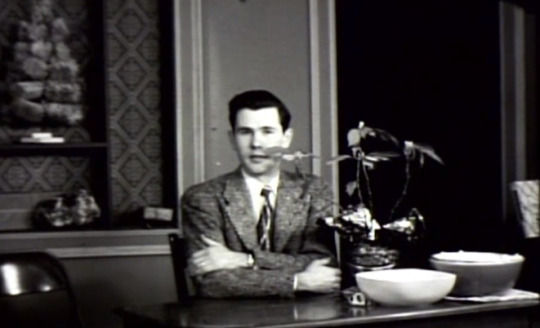
His first on camera credit was an afternoon television show called “The Squirrel’s Nest” in 1949 in Omaha. Carson also wrote the program.
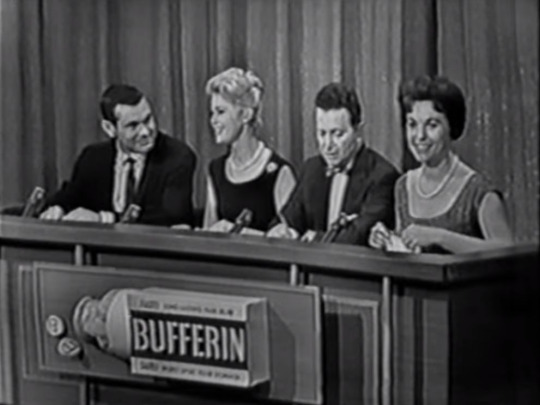
Carson’s first brush with Lucille Ball came in February 1961 as a panelist (along with Betsy Palmer, Harry Morgan, and Bess Myerson) on “I’ve Got a Secret”. Guest Lucille Ball was then starring on Broadway in the musical Wildcat. Moore tells Lucy that her secret will be to get the panel to imitate her based on words that appear on the screen. During Carson’s turn, the word is “ROMANTIC” and then “TIPSY.”

In May 1962, Carson is host of the 14th Annual Emmy Awards, at which Lucille Ball is a presenter.
They would also be host and presenter for the 23rd Annual Emmy Awards in 1971. Lucille Ball is not nominated for “Here’s Lucy”, despite the fact that there were only three nominees in her category. Gale Gordon lost to Edward Asner (”The Mary Tyler Moore Show”) and the writers were nominated for “Lucy Meets the Burtons” but lost to “The Mary Tyler Moore Show.” Lucy attended the Awards with her husband Gary, her daughter Lucie, and her then son-in-law Phil Vandervoort.
At the 36th Annual Emmy Awards in 1980, Lucille Ball was again a presenter, but this time Carson was a nominee, not the host. The hosting duties were taken by Tom Sellek.

A few weeks later, Carson and Ball are on hand at the 14th Anniversary of “The Ed Sullivan Show.” Lucille Ball makes a cameo appearances riding atop an elephant!
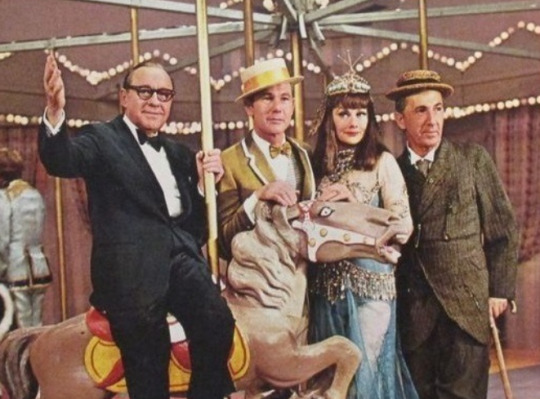
In “Jack Benny’s Carnival Nights” (March 1968), Benny’s all-star cast includes Johnny Carson as a carnival barker introducing Luscious Lucille (Lucille Ball), the red-headed bombshell.

Barker: “The girl who made Little Egypt surrender to the Israelis, Luscious Lucille is the most fantastic dancing girl in all history. When Lucille made her first appearance, Gypsy Rose Lee retired, Lily St. Cyr burst her bubble, and Sally Rand grabbed her fans and flew back to Capistrano.”

Later in the special, Carson plays Jack Benny’s son, Jackie, an aspiring TV comic. Lucy played Jackie’s worn-out mother, Agnes.
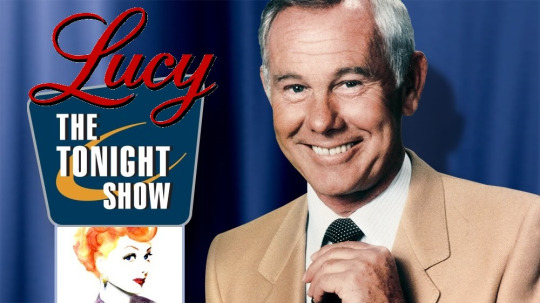
In July 1968 Lucille Ball made her first appearance on “The Tonight Show with Johnny Carson,” having already been a guest on the show hosted by Jack Paar. She was there to promote her new show, “Here’s Lucy.”
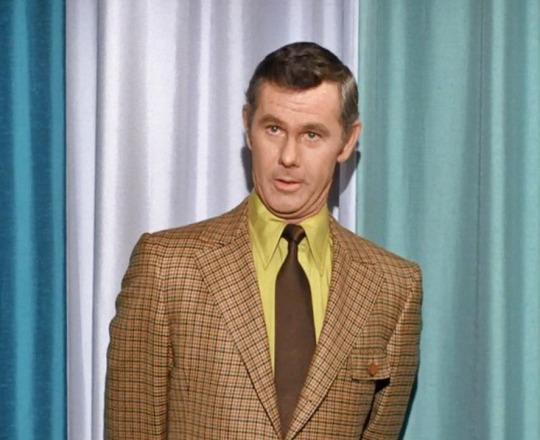
She returned to the guest chair in August 1969, and November 1969, where she brought rehearsal footage of Carson on “Here’s Lucy.”
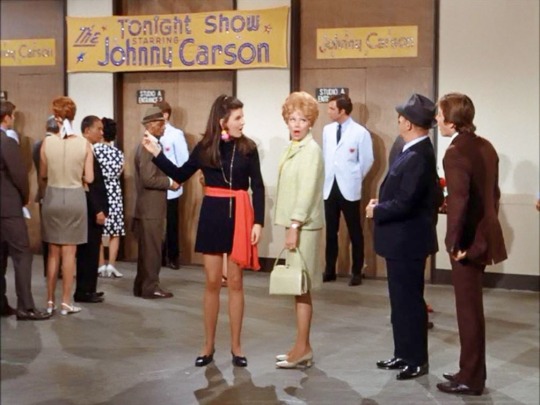
“Lucy and Johnny Carson” (HL S2;E11) aired on December 1, 1969.
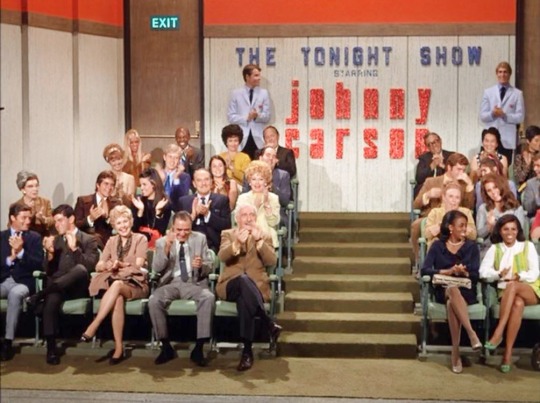
Johnny Carson and Ed McMahon play themselves as Lucy Carter goes to see “The Tonight Show”. In fact, the episode was not shot at the set of the “Tonight Show,” but one replicated by “Here’s Lucy” on their soundstage at Paramount.
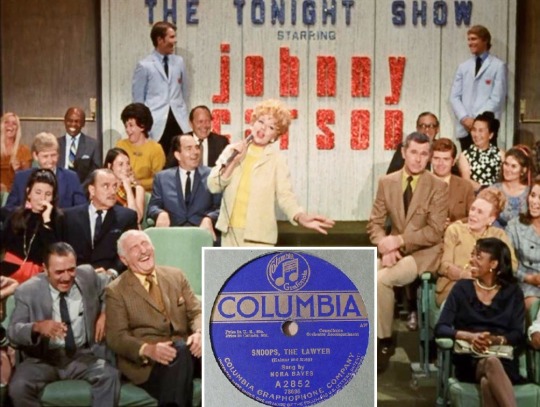
Lucy Carter is picked to play Stump the Band, a staple audience interaction sequence of “The Tonight Show.” Lucy sings “Snoops the Lawyer” a song she says she learned from her father.
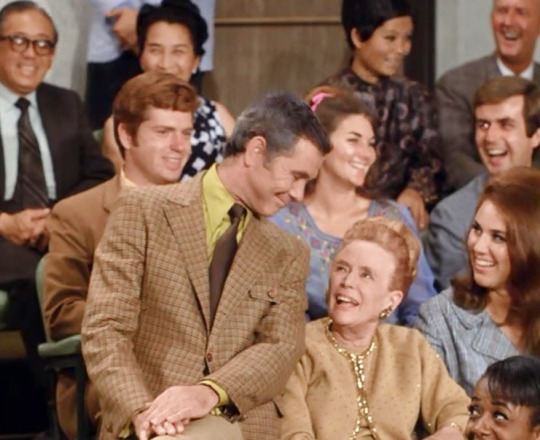
Speaking of parents, sitting just across the aisle from Lucy is her real-life mother, Dede Ball. Carson even directs some of his lines toward her.
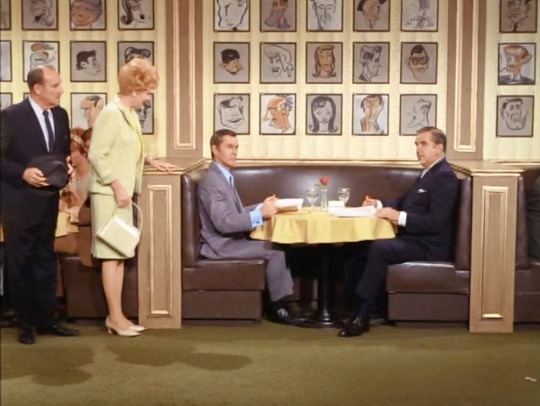
After the show, Harry and Lucy see Johnny and Ed at the Brown Derby restaurant. The Brown Derby scene is very similar to the Brown Derby scene in “Hollywood at Last!” (ILL S4;E16) aka “L.A. at Last!”.
In “Lucy and Johnny Carson,” Lucy jumps up when she sees Gregory Peck and causes the waiter to spill a tray of drinks on Carson.
In “Hollywood at Last!” Lucy jumps up when she sees Gregory Peck and causes the waiter to spill a tray of cream pies on William Holden.
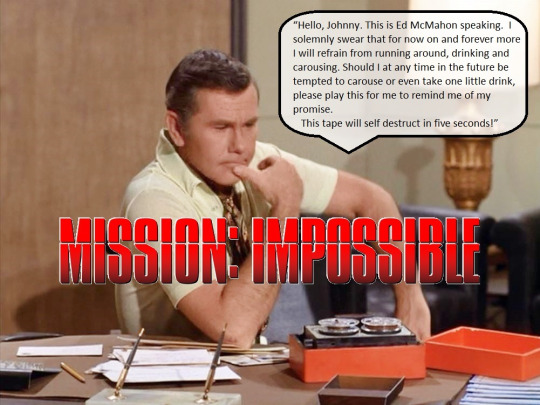
The episode opens with a spoof of the TV series “Mission: Impossible” (1966-73), which was a Desilu / Paramount series.
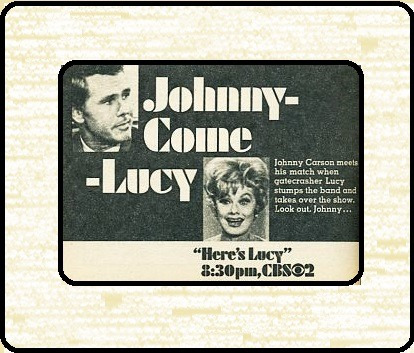
In 1970, Lucille Ball made two more appearances on “The Tonight Show with Johnny Carson”: in February and November.

In between, in September 1970, Carson, Ball and other stars helped Dean Martin kick off the sixth season of “The Dean Martin Show.”
Lucile Ball made several more appearances on “The Tonight Show starring Johnny Carson” throughout the 1970s:
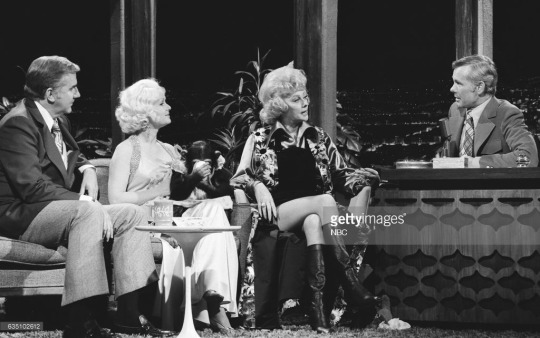
1971 ~ May and August
1973 ~ November
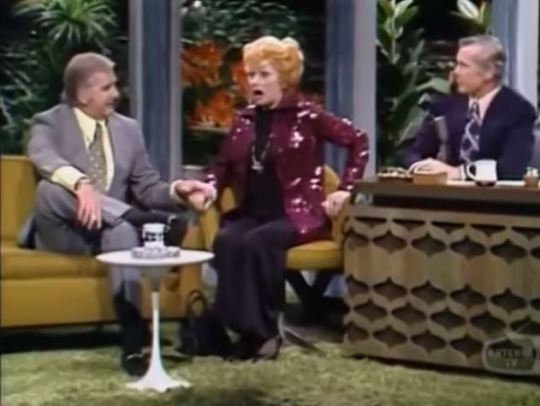
1974 ~ March (with surprise guest Desi Arnaz Sr.)
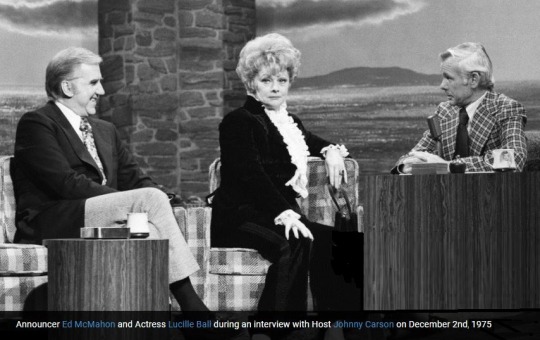
1975 ~ December
1977 ~ April and November
1980 ~ February
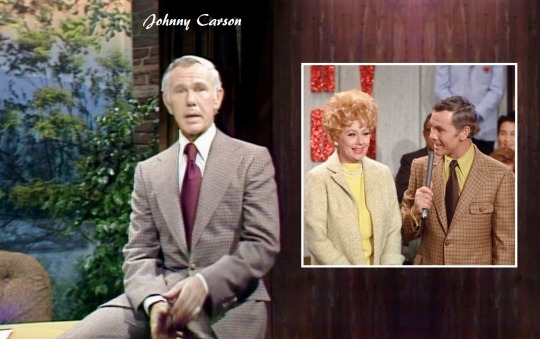
In 1976, Carson was happy to participate in "CBS Salutes Lucy: The First 25 Years” recalling his time on her show in a segment titled “Being Upstaged.”

In 1978, Carson and Ball did two tribute shows: “A Tribute To Mr. Television Milton Berle” and “Happy Birthday, Bob!” a celebration of Bob Hope’s 75th birthday at the Kennedy Center.
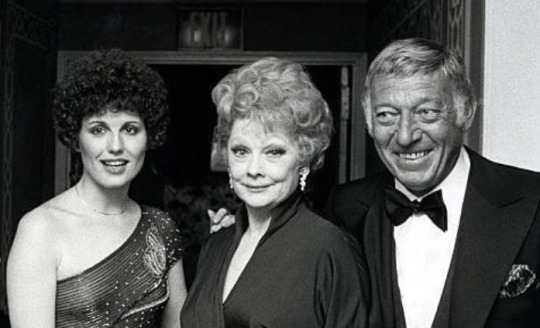
On May 6, 1979, Johnny Carson received an award from the Friars Club during a testimonial dinner at Waldorf-Astoria and friends such as Lucille Ball was accompanied by her husband Gary Morton and daughter Lucie Arnaz.

In 1980, Lucille Ball made the momentous decision to break with CBS and sign a contract with NBC. The event was publicized by a fact meets fiction special titled “Lucy Moves To NBC” in which the NBC stars welcome Ball to the Peacock Network. Carson played himself. Lucy’s Secretary announces Carson’s entrance into her office just as Ed McMahon did on “The Tonight Show with Johnny Carson”: “Heeeeeere’s Johnny!” Carson comes in with the “Tonight Show” theme music playing. Breaking the fourth wall, he cuts off the studio audiences’ applause with a sweeping gesture and they instantly fall silent, just as he did on his talk show. Carson delivers some one-liners about his favorite target, Burbank. There is also some innuendo about Johnny Carson’s work schedule at NBC. In 1980,after more than a year of speculation, Carson finally re-negotiated his contract with the network for a shorter work week, only doing one hour a night, four nights a week. Perhaps not so coincidentally, the evening this special aired, Johnny’s guest was Bob Hope, who will be the next NBC star through Lucy’s office door.
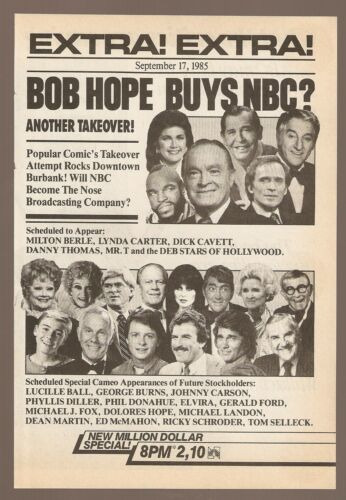
Although Lucy’s tenure at NBC yielded very little, she did join Bob Hope on numerous specials, including “Bob Hope Buys NBC?” in May 1985. Ball and Carson both have cameos in the tongue-in-cheek program.

As years went on, Ball and Carson were often part of tribute shows for other celebrities:
“AFI Achievement Award: A Tribute to Billy Wilder” ~ March 6, 1986
“America’s Tribute to Bob Hope” ~ March 5, 1988
“AFI Life Achievement Award: A Salute to Jack Lemmon” ~ March 10, 1988
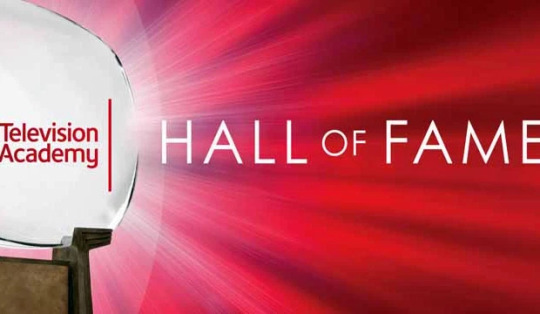
Their final appearance on screen together was for “The Fifth Annual Television Academy Hall of Fame” on January 23, 1989, just a few months before Ball’s death. She inducted her friend Red Buttons into the Hall of Fame. Both Lucy and Johnny were former honorees.
Johnny Carson was married four times - twice to his second wife Joanna. He had three children. He died in 2005, age 79, of emphysema. He will forever be known as “The King of Late Night”.
Carson received six Emmy Awards, the Television Academy's 1980 Governor's Award, and a 1985 Peabody Award. He was inducted into the Television Academy Hall of Fame in 1987. Carson was awarded the Presidential Medal of Freedom in 1992 and received a Kennedy Center Honor in 1993.
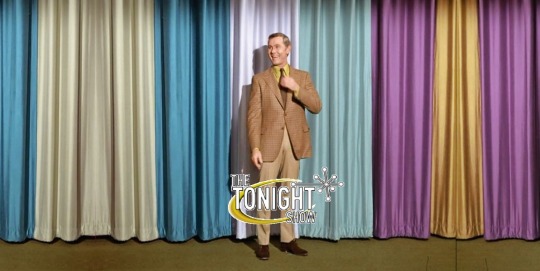
4 notes
·
View notes
Text
THE FATEFUL JOURNEY OF IBC-13

Forget about Primetime Bida, Telebabad, Kapamilya Gold and even Afternoon Prime. There is a TV Network that used to be Number 1 in the 70s until RPN-9 snatched the lead in the 1980s, The Intercontinental Broadcasting Corporation or IBC for short. We will look back on how IBC got its success and failures before rebounding.
Beginnings
On March 1, 1960 at 6:30 PM, Inter-Island Broadcasting Corporation was founded by Dick Baldwin. At the same time, DZTV Channel 13 went on air. The original studios was at the corner of P. Guevarra St. (formerly Little Baguio) in San Juan City from 1960 to 1978. The station's programming consisted of mostly foreign programs from CBS and a few local shows. In 1962, Andrés Soriano, Sr. would acquire the network in 1962. Soriano was also a majority owner of the Radio Mindanao Network (RMN) and the Philippine Herald newspaper. Soriano's combined media interests formed the first tri-media organization in the Philippines. Andrés Sr. Died on December 30, 1964 in Boston, Massachusetts. His namesake son Andrés Soriano, Jr. took over his father's business including Channel 13.
As the de facto television arm of the RMN, it partnered with the RMN radio stations for coverages of the general elections of 1969 and 1971. The station had relay transmitters to bring its programs to viewers in Cebu and Davao, with plans to open more in other cities.
In between 1970 and 1972, IBC launched its color transmission system named "Vinta Color" named after the vintas from Zamboanga, becoming the third network in the Philippines to convert to all-color broadcasts, after ABS-CBN and RPN.
Ben Aniceto became the station manager of DZTV Channel 13 from 1973 to 1976. Before this, he was station manager of ABS-CBN from 1971 to 1972 before returning to ABS-CBN from 1986 to 1987.
The First Intercontinental Broadcasting Corporation (1975-1990)
On February 1, 1975, due to a constitutional limitation prohibiting the ownership of media by non-Filipinos or corporations not 100% Filipino owned, the network was acquired by a crony of Ferdinand Marcos, Roberto Benedicto who also owned Kanlaon Broadcasting System (KBS), and was renamed Intercontinental Broadcasting Corporation (IBC). IBC would launch an FM station DWKB-FM the same year. Marking the relaunch, the network debuted its vinta logo (which would be used until 1978 in two iterations).
In 1976, IBC metamorphosed into one of the country's most viewed TV network with its primetime lineup and full length local and foreign films aired on this channel. This catapulted IBC in the number one slot among the four rival networks and also emphasized itself as the birthplace of the golden age of Philippine television, with many top series headlined by hit stars on radio, TV and film.
Through the blood and sweat of its employees and the income generated from its programs, the network built and finally moved to its present home at the modern Broadcast City, together with its affiliated networks RPN and BBC in July 1978. The complex was a 55,000 square metre tract located at Capitol Hills, Diliman, Quezon City and at the same time, IBC moved its transmitter to San Francisco Del Monte, Quezon City to replace the old transmitter in San Juan. By 1982, IBC would lose its top spot to RPN following Eat Bulaga's popularity, albeit with many great local and foreign programs that were popular among viewers.
After the People Power Revolution, IBC, with 20 television stations that time, was sequestered by the government. A board of administrators was created to run the station. All of the stocks and assets of IBC, and its sister networks RPN-9 and BBC-2 were sequestered by the Presidential Commission on Good Government (PCGG).
When it became a state channel a new logo debuted featuring IBC and 13 on separate circles, a revamp of an earlier logo which debuted in 1980. The new slogan "Basta Pinoy sa Trese" was in a circle to commemorate the People Power Revolution.
President Corazon Aquino turned over IBC and RPN to the Government Communications Group and awarded BBC through an executive order to ABS-CBN. When BBC closed down, IBC absorbed majority of its displaced employees, thus doubled the operating expenses of the network. Cost of programs went up three-fold. Line-produced shows and co-production ventures with some big film companies like Viva, Regal, and Seiko were favored, aside from their station-produced programs. The top rated shows of IBC were pirated by rival networks, however it scored a victory when it acquired the then ABS-CBN program Loveli-ness in 1988, starring Alma Moreno. Cost of programs, talent fees and TV rights increased tremendously. IBC could no longer afford to produce its own shows, save for its news and current affairs programming and special events. In 1987, IBC was renamed as E13 and adopted a new slogan, "Life Begins at 13", noted for the butterfly logo in the form of the letter E and the number 13. The corporate name however, is still "Intercontinental Broadcasting Corporation".
IBC fell from fourth place after GMA-7 regained the ratings lead. By 1988, when ABS-CBN became the top-rating network, IBC is now dead last in the ratings.
In 1989, the IBC brand returned after two years. The network adopted a new image at the same year, Pusong Pinoy, Pusong Trese (Heart of Filipino, Heart of Thirteen), to recapture the glory days it once had. But because of the sequestration, periodic change of management and the internal problems, the network started to lose the support from its advertisers. Also on that year, KB 89.1 becomes 89 DMZ and changed its callsign to DZMZ.
Islands TV-13 (1990-1992)
Islands Broadcast Corporation under Mr. Alfonso Denoga and Mr. Gil Balaguer took over the management and the marketing of IBC 13 (which was branded as Islands TV-13) in October 1990, at the time when IBC 13 was dead last in the ratings. The new logo features a three triangles and a slogan, The Newest Network adorn on the logo. It was in the later part of its operations that ratings and income suffered due to mismanagement which caused labor unrest. In March 1993, the Makati RTC issued the court order stopping Islands Broadcast Corporation as the marketing and sales agent of IBC 13 due to unpaid financial obligations to the network as the contract of Islands expired on February 28, 1993.
The Second Intercontinental Broadcasting Corporation (1992-Present)
In October 1992, Islands TV-13 was rebranded back to IBC and became a 100% government owned station by virtue of a compromise agreement between PCGG and Roberto Benedicto. The management and marketing were returned to IBC's board of directors. The programming remained at a standstill in preparation for the launching of a new image of the station.
It was on May 27, 1994 when IBC launched its new slogan "Pinoy Ang Dating" ( "Filipino styled") with a Filipino-like visually enticing music video featuring Grace Nono, an innovation in terms of station identification. Despite limited resources, programming improved but the battle for audience share continued. Advertisers became more responsive to marketing efforts. The following year, IBC began to broadcast its programs nationwide via "Nationwide Satellite Broadcast".
In 1996, Vintage Enterprises transferred to IBC as part of the launching of Vintage Television (VTV), a primetime block that aired on IBC with PBA, Blow by Blow and other Vintage Sports-produced programs after moving from another government-owned station, People's Television Network (PTV). The block helped IBC-13 land third in the primetime ratings, mainly credited to the airing of the PBA games.
Later in the year 2000, Viva Entertainment's subsidiary Viva Television acquired Vintage Enterprises (including VTV on IBC block) from the Velez family and changed its name to Viva TV. It was a primetime sports and entertainment block on IBC and continued until 2002. At the same time, 89 DMZ signs off for the last time (prior to 89DMZ’s final sign-off, it had a program that simulcasted on IBC and 89DMZ which was then called DMZ-TV, a 60-minute musical variety show).
In 2001, IBC and Blockbuster Broadcasting System went into a government-sponsored bidding and the Vera Group, through Blockbuster Broadcasting System, won the rights to the frequency and the facilities. 89 DMZ rebrands to Wave 89.1 (callsign then changed to DWAV). However, the network still shares its transmission facilities of IBC 13 until 2014 when it began transmitting from Antipolo.
Rehabilitation of the transmitter and other technical facilities where initiated in the network's flagship and provincial stations. However, in early 2003, Viva TV on IBC was ended after Viva decided not to renew a blocktime agreement with IBC due to high blocktime costs and low ratings.
Despite this, then before Star for a Night Grand Finals (held at the Philsports Arena in Pasig), its last Viva TV-produced program was aired on IBC on March 1, 2003. Viva Main Event is its only program which still airs in IBC recently, as it became part of the TV5 sports programming block AKTV, making Viva Sports own a mere 20% of the block. At the same time, IBC also installed a new Harris 60-kilowatt transmitter for clearer TV reception, and utilized the services of the APSTAR 1 Satellite for a broader international reach.
On January 1, 2002, IBC launched its new logo and its new slogan "New Face, New Attitude" with a new station ID, and its programming, including those from the news division (the relaunched Express Balita, Entrepinoy, Good Take, and Linawin Natin plus Celebrity.com, IBC’s weekly entertainment program)
On December 12, 2003, IBC launched again its new logo and its new slogan "Ang Bagong Pilipino" (The New Filipino) with a freestyle station ID.
In late 2007, IBC inked a deal with the Makisig Network, led by Hermie Esguerra, as a primetime block-timer of IBC. However, Makisig Network's programs were not aired due to questions on the propriety of the terms and conditions of the agreement. Said agreement expired in October 2008.
After four decades of serving the network's dominance and entertainment programing, IBC-13's studios and facilities are abandoned due to negligence and their network's mismanagement. Their studio equipment, cameras, lighting and props are useless, dilapidated and very old. Cash and budgets were cut short and they cannot afford to utilize radio-TV operations. Their programming and airtime were lost after suffering from a network war in the late 1980s and the 1990s and many employees lost their jobs. The network suffered more than 800 million pesos worth of backwages to its employees, some of them are old-timers or those who worked in the network since the 1980s.
At present, IBC 13 has 200 regular employees as of 2016, while 29 of those are talents or in a "contractual basis", particularly from the news and public affairs and production.
The management tried to revive the ill-fated network but it failed thereafter over a span of 30 years and six Philipppine presidents (Corazon Aquino, Fidel Ramos, Joseph Estrada, Gloria Macapagal Arroyo, Benigno Aquino III and Rodrigo Duterte).
There were many plans to sell and privatize IBC and RPN. TV network ABS-CBN was planning to buy the network's blocktime to address signal problems and mimic the former's programs. However, ABS-CBN could not join the privatization bid due to ownership regulations.
In 2011, IBC has entered into a joint venture agreement with Prime Realty, an affiliate of R-II Builders Group of Reghis Romero Jr. The agreement called for the development of 3.5 hectares of Broadcast City. With this joint venture agreement with a private business enterprise, the Aquino administration expressed its desire to privatize both RPN and IBC and retain the People's Television (PTV) as a sole-mandated government TV network.It was also announced that conglomerate San Miguel Corporation will join the government-sponsored bidding for the privatization of RPN and IBC.
IBC signed a blocktime agreement with TV5's sports division Sports5 to air live sports coverage via its sports programming block AKTV. It was launched last June 5, 2011, with the AKTV Run held outside SM Mall of Asia in Bay City, Pasay. At the same day, IBC launched a new logo and slogan "Where the Action Is" to reflect the change.
In April 11, 2013, MediaQuest chairman Manny Pangilinan announced that AKTV will no longer be renew the blocktime agreement in May due to high costs and poor ratings, and there has been doubts about the future of the network.
However, according to a news article dated September 26, 2012, former IBC president Eric Canoy hinted that in pursuant to AO 26 which restored its archives, hopefully IBC could reair them as IBC Classics.
IBC recently signed a memorandum of agreement with the Asian Television Content Corporation under Engr. Reynaldo Sanchez as the major blocktimer of the station. ATC @ IBC primetime block with newest programs premiered last June 2, 2014. However, on August 31, 2014, programs under the ATC @ IBC 13 block suddenly no longer aired on the network, possibly due to poor ratings and lack of advertisers' support.
PCOO Secretary Herminio Coloma, Jr. said in a Senate budget hearing for the PCOO last September 3, 2014 that the network will be fully privatized before President Aquino stepping down in the office in 2016 and keeping PTV-4 as the sole government TV network. Process of the privatization will be managed by the Governance Commission for Government-Owned or -Controlled Corporations through the Development Bank of the Philippines. Business tycoon Manny V. Pangilinan is one of the possible bidders for the privatization in which TV5 (a media company under PLDT's MediaQuest Holdings through ABC Development Corporation), despite expiration of blocktime agreement in 2013 (AKTV), is still using IBC's Broadcast City facilities for sports events, including its 2014 FIBA Basketball World Cup coverage. However, MediaQuest also could not join the privatization bid due to ownership rules and regulations that MediaQuest owns TV5 and AksyonTV.
On June 2, 2015, the Philippine Crusader for Justice (PCJ), led by Joe Villanueva, filed a petition to the Supreme Court of the Philippines to nullify the joint venture agreement between IBC and Primestate/R-II Builders for the development of 3.5 hectares of Broadcast City, after the Office of the Ombudsman found the contract to be disadvantageous to the government. The Ombudsman filed a graft case in 2013 against former IBC executives and Primestate.
In January 2016, President Benigno Aquino III, through the Governance Commission for Government-owned and -controlled corporation (GCG) appoved the planned privatization of IBC. The privatization will be undergo public bidding with an estimated floor price of 10 billion pesos. The proceeds of the bidding will be for the increase of state-owned PTV-4's capital to upgrade and modernize their broadcast capabilities. The Development Bank of the Philippines will be the financial adviser for the privatization. Incoming PCOO secretary Martin Andanar has already forwarded the privatization plan to President Rodrigo Duterte's executive secretary Salvador "Bingbong" Medialdea. Andanar will also coordinate with the GCG before the start of the bidding.
Katherine de Castro, daughter of TV Patrol anchor Noli de Castro becomes the President & CEO of the network.
The privatization process of IBC was commenced in October 2016. As of December 2016, five groups have already showed their interest to join the bidding process. These are Ramon Ang of San Miguel Corporation and the groups of former IBC president (and current RMN President/CEO) Eric Canoy and former Ilocos Sur governor Chavit Singson, Dennis Uy of Phoenix Petroleum and William Lima, a businessman from Davao.
In March 2017, IBC operated on a low powered signal but it continues its broadcast on cable and satellite providers. In October 2017, IBC began its test broadcast on digital terrestrial television.
Since late 2018, IBC began to revitalize its infrastructure and its content. By December of the same year, the network transferred its studios and offices to its new building at Capitol Hills Drive corner Zuzuarregui Street, Barangay Matandang Balara, Quezon City to give way for the conversion of Broadcast City, their home for 40 years, into Larossa condominium complex; while re-upgrading its Roosevelt Avenue analog transmitter for the Mega Manila area.
On February 11, 2019, IBC announced a major revamp of its programming, the first since the ATC@IBC block in 2014. It includes archives of IBC's popular entertainment and cultural shows, introduction of documentary and current affairs programs airing from sister station People's Television Network, and other entertainment and sports content from SMAC Television Productions and ATC, among others (including its inaugural season of Community Basketball Association or CBA Pilipinas, the move of CNTV or Chinese News TV to IBC from Net 25, airing of Power to Unite with Elvira, among others. Some of the previous programs including Tukaan, Bakbakan Na, and Chicken Talk were moved to 5 (The 5 Network) and its sister station 5 Plus while the latter (Chicken Talk) still airs via Pinoy Extreme channel).
Reactions
IBC has been abandoned for so long since 1986. But IBC made more changes to its news program which turned out to be "Tutok 13" replacing "News Team 13". IBC needs to be privatized as a classic and music station, while the network will add a morning show to compete with other networks. In my prediction, IBC might be privatized by the Canoy family.
IBC should also force merger with Radio Mindanao Network and Primax Broadcasting Network and keeping the Intercontinental Broadcasting Corporation name as branding for TV operations while operating as a subsidiary of RMN. However, IBC's Radyo Budyong operations might cede to RMN's AM radio stations. RMN should also revive IBC's neglected provincial stations in order to reconnect their reach since the 1990s.
Primax Broadcasting Network on the other hand will be folded into IBC's FM Stations. The Manila station of MemoRieS FM will acquire DWKY 91.5 from Manny Luzon and face competition with DWFT 104.3 FM as 1043 FM2, 100.3 RJFM and 103.5 K-Lite.
When it comes to advertisers, RMN AM and FM stations will attract ACS ads except IBC TV and MemoRies FM which will attract other ads instead of ACS.
If RMN and Primax merges with IBC, the stations including soon to be revived inactive stations will look like this:
Manila
DZTV 13 (IBC-13 Manila)+ DZXL 558 AM (RMN Manila)* DWWW 774 AM DWKC 93.9 FM (93.9 iFM Manila)* DWKY 91.5 FM (MemoRieS FM 91.5)+
Baguio
DWBD 6 (IBC-6 Baguio)+ DZHB 576 AM (RMN Baguio) DWHB 103.9 FM (103.9 iFM Baguio)* DZLL 107.1 (MemoRieS FM 107.1)+
Laoag
DWCS 13 (IBC-13 Laoag)+ DWCK 92.3 FM (92.3 iFM Laoag)* (iFM will move to 92.3 due to DWHP 99.5 becoming 99.5 HP Laoag's sister station of 99.5 RT Manila after being sold to Trans-Radio) DWLW 675 AM (RMN Laoag)* 98.7 FM (MemoRieS FM 98.7)+
Naga
DWTV 13 (IBC-13 Naga)+ DWNX-FM 91.1 (91.1 iFM Naga)* DWNX-AM 1611 (RMN Naga)* DZOK 97.5 FM (MemoRieS FM 97.5)+
Legazpi
DWRB 10 (IBC-10 Legazpi)+ DWWL 98.7 FM (98.7 iFM Legazpi)* DWCT-AM 1557 (RMN Legazpi)* DZCA 105.9 FM (MemoRieS FM 105.9)+
Cebu
DYTV 13 (IBC-13 Cebu)+ DYHP 612 AM (RMN Cebu)* DYXL 93.9 FM (93.9 iFM Cebu)* DYKI 89.9 FM (MemoRieS FM 89.9)+
Iloilo
DYJB 12 (IBC-12 Iloilo)+ DYRI 774 AM (RMN Iloilo)* DYIC 95.1 FM (95.1 iFM Iloilo)* DYOZ 100.3 FM (MemoRieS FM 100.3)+
Bacolod
DYBD 11 (IBC-11 Bacolod)+ DYHB 747 AM (RMN Bacolod)* DYHT 94.3 FM (94.3 iFM Bacolod)* 91.1 FM (MemoRieS FM 91.1)+
Tacloban
DYBC 12 (IBC-12 Tacloban)+ 630 AM (RMN Tacloban)* DYXY 99.1 FM (99.1 iFM Tacloban)* 91.9 FM (MemoRieS FM 91.9)+
Cagayan de Oro
DXCC-TV 10 (IBC-10 Cagayan de Oro)+ DXCC 822 AM (RMN Cagayan de Oro)* DXVM 99.1 FM (99.1 iFM Cagayan de Oro)* DXCS 92.7 FM (MemoRies FM 92.7)+
Ozamiz
DXWV 13 (IBC-13 Ozamiz)+ DXSY 1242 AM (RMN Ozamiz)* DXSY 96.1 FM (96.1 iFM Ozamiz)* 101.1 FM (MemoRieS FM 101.1)+
Butuan
DXRT 13 (IBC-13 Butuan)+ DXBC 693 AM (RMN Butuan)* DXXX 100.7 FM (100.7 iFM Butuan)* 104.7 FM (MemoRieS FM 104.7)+
Davao
DXTV 13 (IBC 13 Davao)+ DXDC 621 AM (RMN Davao)* DXXL 93.9 FM (93.9 iFM Davao)* DXYP 102.7 FM (MemoRieS FM 102.7)+
General Santos
DXSA 10 (IBC-10 GenSan)+ DXMD 927 AM (RMN General Santos) DXCK 91.9 FM (91.9 iFM General Santos)* 93.9 FM (MemoRieS FM 93.9)+
Zamboanga
DXZB 13 (IBC-13 Zamboanga)+ DXRZ 900 AM (RMN Zamboanga)* 93.1 FM (93.1 iFM Zambaonga)* 101.9 FM (MemoRieS FM 101.9)+
* - owned by/affiliated with Radio Mindanao Network + - owned by Intercontinental Broadcasting Corporation
youtube
Watch The Original No. 1: IBC-13's Legacy to Philippine Television on March 8, Friday 9:30PM on IBC.
(DISCLAIMER: This post is for factual basis and is to be veirified at the soonest possible time by some sources. Don’t be assured yet, but it is just for the contributor’s point of view. Majority of the source came from Wikipedia.)
(NOTE: The contributor of this post is Carl Veluz, a good friend of the EIC/Publisher of KRD.)
KRD Welcomes everyone who can contribute to ‘The Blog that tells Stories and More’. Send in via email: [email protected] with the subject ‘KRD Contributor’ with your draft as attachment, and your details of your work. You may include your personal details, but we respect your privacy if we opt to include some other details or not depending on the individual’s request. You can also send in as private message via Kuya Rexdel’s Diaries Facebook page (fb.com/KRDOfficialPH).
0 notes
Text
Millie Jackson


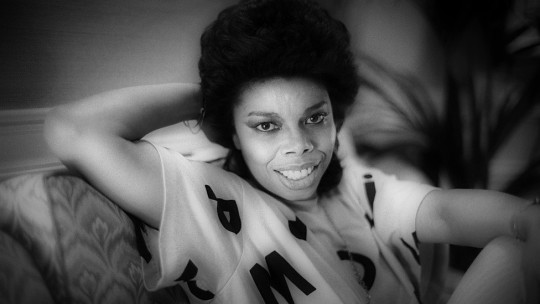
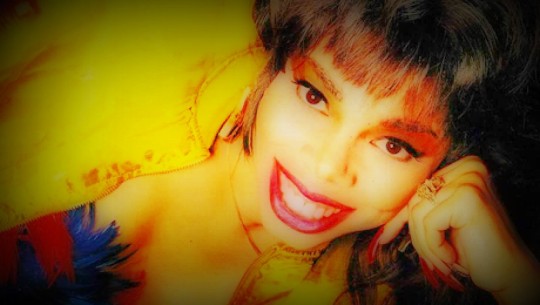
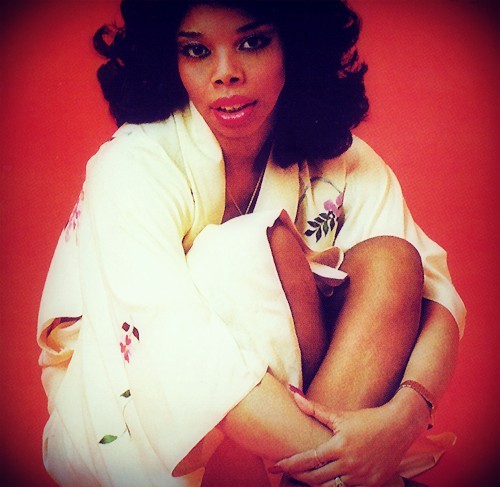

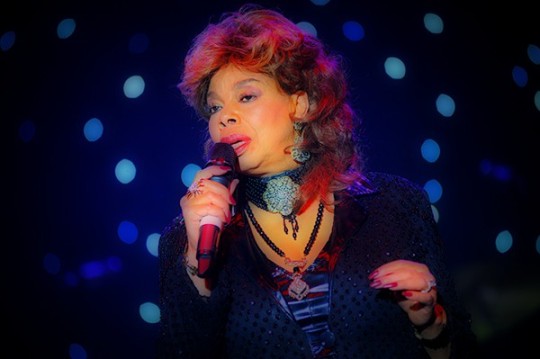
Mildred Virginia (Millie) Jackson (born July 15, 1944) is an American singer-songwriter. Six of her albums have been certified gold by the RIAA for over 500,000 copies.
Her vocal performances are often distinguished by long, humorous, and explicit spoken sections in her music, which she started doing on stage to get the attention of the audience. She has also recorded songs in a disco or dance music style and even some country styled songs. She is the mother of Keisha Jackson.
Early life
Born in Thomson, Georgia, Jackson is the daughter of a sharecropper. Her mother died when she was a child and subsequently, she and her father moved to Newark, New Jersey. By the time Jackson was in her mid-teens, she had moved to Brooklyn to live with an aunt. She occasionally worked as a model for magazines like JIVE and Sepia.
Career
Jackson's singing career reportedly began on a dare to enter a 1964 talent contest at Harlem nightclub Smalls Paradise, which she won. Although she first recorded for MGM Records in 1970, she soon left and began a long association with New York-based Spring Records. Working with the label's in-house producer, Raeford Gerald, her first single to chart was 1971's deceptively titled "A Child of God (It's Hard to Believe)," which reached number 22 on the R&B charts. In 1972, Jackson had her first R&B Top Ten single with the follow-up, "Ask Me What You Want", which also reached the pop Top 30, then "My Man, A Sweet Man" reached #7 R&B; all three hits were co-written by Jackson. "My Man, A Sweet Man" retains its popularity today for northern soul enthusiasts and is played on the radio in the UK and quoted as an example from this musical genre as is her 1976 recording, "A House for Sale". The following year brought her biggest single success and her third Top Ten hit, "It Hurts So Good," which made #3 on the R&B charts and #24 on the Billboard Hot 100 pop chart. The single was featured on the album of the same name and in the blaxploitation film Cleopatra Jones, also appearing on that film's soundtrack along with the song "Love Doctor".
In 1974, she released the album Caught Up, which introduced her innovative style of raunchy rap. The featured release was her version of Luther Ingram's million-seller, "(If Loving You Is Wrong) I Don't Want to Be Right", for which she received two Grammy nominations. By now, she had switched producers to work only with Brad Shapiro, recording at Muscle Shoals Studio in Alabama with the renowned Muscle Shoals Rhythm Section. She continued to record most of her material for Spring there, including the follow-up album, Still Caught Up.
Over the next ten years, Jackson had a string of successful albums and numerous R&B chart entries, the biggest being her 1977 version of Merle Haggard's country hit "If You're Not Back In Love By Monday". That hit single was followed by many more, including her version of the Boney M. song, the disco single, "Never Change Lovers In The Middle of The Night." This single peaked at #33 on the Black Singles chart in 1979.
Jackson recorded an album in 1979 with Isaac Hayes called "Royal Rappin's" and the same year saw her release a double album, "Live And Uncensored", recorded in concert at Los Angeles venue, The Roxy. Jackson also formed and produced the group Facts of Life. They had a major hit in 1976 with "Sometimes" (#3 R&B, #31 Pop).
Jackson found herself without a label when Spring closed down in 1984, but in 1986, she signed with Jive Records in a deal that produced four albums and resulted in further R&B Top Ten hits with "Hot! Wild! Unrestricted! Crazy Love" and "Love Is a Dangerous Game". She appeared on an Elton John track in 1985, "Act Of War", which was a Top 40 hit in the UK, but failed to chart in the USA. In 1991, she wrote, produced and starred in the successful touring play Young Man, Older Woman, based on her album of the same title for Jive.
On November 24, 1994, Jackson appeared in the Thanksgiving episode Feast or Famine of Martin as Florine.
In 2000, her voice featured in "Am I Wrong" by Etienne de Crécy, sampled from her performance in "(If Loving You Is Wrong) I Don't Want to Be Right".
Jackson may be most famous in the internet age for her album covers, which frequently appear on "worst ever" lists. E.S.P. (Extra Sexual Persuasion) features Jackson peering into a crystal ball that accentuates her cleavage; Back to the S t! depicts Jackson sitting on a toilet.
Jackson now runs her own record label, Weird Wreckuds. After a lengthy hiatus from recording, she released her 2001 album, Not For Church Folk, which marked a return to her "tell-it-like-it-is" lyrical style with an Urban contemporary sound. The album features the singles "Butt-A-Cize" (a dance song) and "Leave Me Alone" (a ballad). The album also features a collaboration with rapper Da Brat on the song "In My Life."
Jackson had her own radio show in Dallas, Texas for 13 years. Broadcasting via remote from her home in Atlanta, Jackson worked in afternoon drive-time from 3-6 pm on KKDA 730 AM, until January 6, 2012.
In 2006, five of Jackson's best-selling albums – Millie Jackson (1972), It Hurts So Good (1973), Caught Up (1974), Still Caught Up(1975), and Feelin' Bitchy (1977) – were digitally remastered and released on CD with bonus tracks. All of Jackson's Spring Records-era albums are available from Ace Records in the UK.
An Imitation of Love was re-issued on CD in 2013 by the Funkytowngrooves label in a remastered, expanded edition. Other albums released on the Jive and Ichiban labels remain out of print, though some of those songs appear on compilation CDs.
On February 6, 2012, the documentary, Unsung - The Story of Mildred 'Millie' Jackson aired on the TV One network.
Jackson performed at Washington, D.C.'s historic Howard Theatre on August 3, 2012, and at B.B. King's Blues Club in New York on August 4, 2012. On June 6, 2015 Jackson was inducted into the Official Rhythm & Blues Music Hall of Fame in Clarksdale, MS.
Personal life
She has two children: Keisha Jackson, born in the 1960s before she was married, and son Jerroll born in the late 1970s. She is not related to the Jackson family of singers and musicians from Gary, Indiana.
Discography
AlbumsSingles
"A Little Bit of Something"
"A Child of God (It's Hard to Believe)" (US: #102)
"Ask Me What You Want" (US: #27)
"My Man, A Sweet Man" (US: #42), (US R&B: #7) (UK: #50)
"Breakaway" (US: #110)
"It Hurts So Good" (US: #24), (US R&B: #3)
"I Miss You Baby"
"How Do You Feel the Morning After" (US: #77)
"I'm Through Trying To Prove My Love To You"
"I Got to Try It One Time"
"(If Loving You Is Wrong) I Don't Want to Be Right" (US: #42)
"Leftovers" (US: #87)
"Loving Arms"
"The Rap"
"A House for Sale"
"Bad Risk"
"Feel Like Making Love"
"There You Are"
"I Can't Say Goodbye"
"If You're Not Back in Love By Monday" (US: #43)
"A Love of Your Own"
"All The Way Lover" (US: #102)
"Sweet Music Man" (US R&B #33)
"Keep The Home Fire Burnin'" (US R&B #83)
"Never Change Lovers In The Middle of The Night" (US R&B: #33)
"We Got To Hit It Off" (US R&B #56)
"A Moment's Pleasure" (US R&B #70)
"Kiss You All Over"
"Despair"
"Do You Wanna Make Love" feat. Isaac Hayes (US R&B #30)
"This Is It (Part I) (US R&B #88)
"You Never Cross My Mind"
"I Can't Stop Loving You" (US R&B #62)
"Anybody That Don't Like Millie Jackson"
"I Had to Say It"
"It's Gonna Take Some Time This Time"
"Special Occasion" (US R&B #51)
"Passion"
"E.S.P."
"I Feel Like Walkin' In The Rain" (UK: #55)
"Sister in the System"
"Hot! Wild! Unrestricted! Crazy Love" (US R&B #9) (UK: #99)
"Act of War" feat. Elton John (UK: #32)
"It's A Thang" (US R&B #79)
"Love Is A Dangerous Game" (US R&B #6) (UK: #81)
"An Imitation of Love" (US R&B #58)
"Something You Can Feel" (US R&B #45)
"You Knocked the Love (Right Outta My Heart)"
"Will You Love Me Tomorrow"
"Young Man, Older Woman"
"Living With A Stranger"
"Taking My Life Back"
"Love Quake"
"Check in the Mail"
"Chocolate Brown Eyes"
"Breaking Up Somebody's Home"
"The Lies That We Live"
"Did You Think I Wouldn't Cry"
"Butt-A-Cize"
"Leave Me Alone"
"Black Bitch Crazy"
Wikipedia
6 notes
·
View notes
Text
Vans releases new comfy sneakers that feel 'like you’re walking on a cloud'

Vans unveils new ComfyCush technology for the classic Era style. (Photo: Courtesy of Vans)
Comfort and style stride side by side with Vans’ latest footwear launch. The new ComfyCush Era sneakers, the company says, feel as if “you’re walking on a cloud.” Vans has been working on thenew comfort-based technology since 2016, and it’s now finally ready to be shared with the world, starting with the classic Era style.
The original Era sneakers first debuted in 1976, 10 years after the Vans company was founded in Anaheim, Calif. Interestingly, the sneakers were designed by two skateboarders: Tony Alva and Stacy Peralta. The Eras feature a low, top-lace structure, durable double-stitched canvas upper, padded tongue and waffle outsole.
The decision to launch ComfyCush was simple. It’s about diversifying Vans’ available options. “Our consumers make us who we are today, so by listening closely, we built exactly what they were asking for,” Matt Pino, Vans’ global footwear category manager tells Yahoo Lifestyle. “More comfort without sacrificing style, which led to pushing the innovation of the Era to the next level. We’ve been working on this technology since 2016, really focused around a rubber product (foam) that was designed specifically for comfort.”

Vans will release new ComfyCush Era colors and styles throughout the season. (Photo: Vans)

A closeup of the new Vans ComfyCush footbeds (Photo: Vans)
Aesthetically, the new ComfyCush Era sneakers look exactly like the original. The ComfyCush elements are hidden within the foundation and structure of shoes. They feature new tongue tie-down elastic straps that help “improve the overall fit and feel,” says Pino. “It eliminates the possibility of the tongue sliding to either the medial or lateral side of the foot.” There’s additional arch support and a new foam and rubber cushion and grip that help keep your feet more comfortable all day long.
Bridging the gap between comfort and style seems like a no-brainer, especially for a brand like Vans, which is competing with the juggernauts Adidas, Converse and Nike. “It’s important our consumers know we aren’t asking them to trade off any of our icons, but that we are simply providing them with an option that may meet the need of a particular lifestyle — that doesn’t compromise style,” says Pino.
Three Yahoo Lifestyle editors put the new ComfyCush Era sneakers to the test. Read our firsthand reviews below.
Editor test:
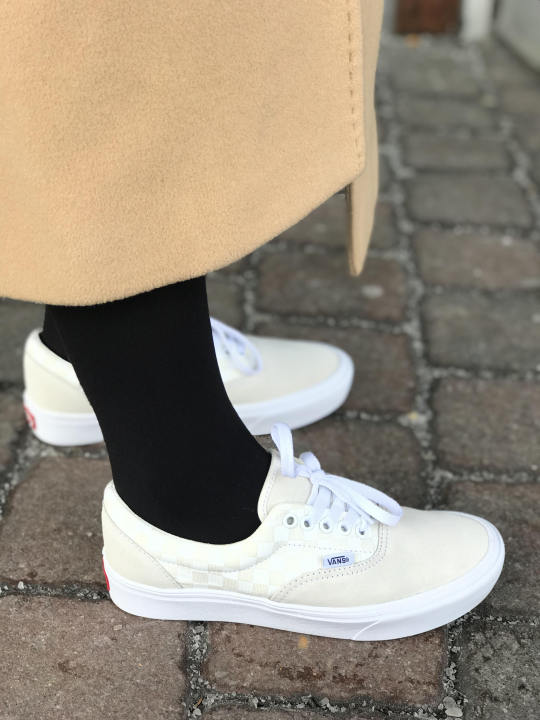
Julie Tong, Yahoo Lifestyle’s fashion editor, tests out the new Vans ComfyCush Era sneakers in Syracuse, N.Y. (Photo: Julie Tong)
Julie Tong, Yahoo Lifestyle fashion editor
“I’ve been a Vans fan ever since I was a teen. I can still remember walking through my high school hallways, past the rows of burnt-orange lockers, wearing my trusty pair of navy-blue Era sneakers. I wore them until they were smudged with dirt and the blue canvas started to wear away. Still, I didn’t care. I loved them. Now, hearing that Vans is making my favorite sneakers more comfortable? I had to try them out.
“Over the weekend, I tested the new Vans ComfyCush Era sneakers while visiting my boyfriend in upstate New York. At first glance, I loved the off-white and checkered design. I don’t usually wear white sneakers, but the print and Vanilla shade felt refreshing, yet still inherently Vans. The real ‘treat’ came when I placed my feet inside the shoes. On Sunday, I spent the afternoon going to brunch, grocery shopping at Wegmans, and ended the day catching a flight back to Manhattan. There were even times I wore them on the icy snow patches that lined the Syracuse streets. I was surprised to find how well they kept up through it all. No slippage! My feet stayed dry and warm even in these harsh conditions (because let’s be real, they weren’t intended to be worn in the snow).
“Throughout my day, I noticed how consistently sturdy the footbeds felt and how soft the cushions were that supported my ankles. I’m someone who has wide feet, and they never once felt too tight around my toes, which is a big plus. In my experience, they’re perfect for running errands and traveling in, but most importantly — walking in. I think the longer I wear them, the more they will mold to my feet, too. The final verdict? They’re keepers. I now have a reason to bring these beloved sneakers back into my life.”

Dana Oliver, Yahoo Lifestyle beauty director, tests out the new ComfyCush Era sneakers on a full day of errands. (Photo: Dana Oliver)
Dana Oliver, Yahoo Lifestyle beauty director
“This was my first time ever wearing a pair of Vans, and the experience was far from what I had expected. I’d previously had my eye on the brand’s classic slip-on sneakers — as a new mom, I need shoes that are simple to get on and off when taking care of an infant. I gave the ComfyCush Era sneakers a trial run on a busy Saturday: My schedule included a Baby & Me yoga class, shopping at Whole Foods and tidying up at home. With my son all set in his car seat, and the Lyft driver just four minutes away from picking us up, I was surprised at how easy it was to get quickly dressed in the kicks.
“The slender cut fit my narrow feet perfectly. Not to mention, after gaining roughly an extra half size in foot length post-pregnancy, I still managed to have enough toe space in the shoes. As I maneuvered around the grocery store with a stroller and no shopping basket, I soon learned why these sneakers carry the ComfyCush title: They make your feet like you’re gliding on air.
“The thick sole also managed to help with my posture, forcing me to stand straighter and walk with even more confidence. And with all the bending down I had to do to pick up my son or his teething toys, the fabric of the shoe didn’t awkwardly bend or bulk.”
“While I love the subtle checkerboard design of the Marshmallow and True White colorway I tested, I wouldn’t sport these every day, simply because it would be too difficult to keep them pristine. So overall, I’m giving these ComfyCush Era Vans 4 out of 5 stars!”

(Photo: Vans)
Adrianna Barrionuevo, Yahoo Lifestyle senior beauty editor
“I’ve been a Vans loyalist for as long as I can remember. I would go as far as to call myself a Vans aficionado. So when I heard about the new Vans ComfyCush Era sneakers, I was beyond excited to slip on a pair of my favorite style. While I wasn’t skateboarding or strolling down to TK Burger in my old home of Newport Beach, Calif., I was navigating the busy streets of Manhattan to make it to Central Park for off-leash hours with my pup.
As soon as I took my first few steps, I noticed a difference in comfort level. From my heel to my toes, I felt much more supported and cozy compared to previous styles I’ve worn. I ended up wearing my sneakers all day long, clocking in a total of about 15,000 steps, and my feet felt comfortable every step of the way (even when I had to chase my pup to get him back on the leash to head home). I would recommend these to anyone looking for a stylish, yet casual shoe, whether they’re skateboarding or strolling around the city.”
You can shop the new ComfyCush Era unisex sneakers below.
Shop it: $60, vans.com
The editors at Yahoo Lifestyle are committed to finding you the best products at the best prices. At times, we may receive a share from purchases made via links on this page.
Read More from Yahoo Lifestyle:
• Wayfair’s major Presidents Day sale started early: Here’s every deal • Presidents’ Day 2019: The best tech deals on TVs, laptops and more • Shop our top favorite picks from Coach’s 50 percent off sale
Follow us on Instagram, Facebook and Twitter for nonstop inspiration delivered fresh to your feed, every day.
yahoo
#van#yahoo shopping#vans era#sneakers#vans#_draft:true#editor pick#shoes#_lmsid:a0Vd000000AE7lXEAT#_revsp:wp.yahoo.style.us#era sneakers#editor review#_author:Julie Tong#style#_uuid:752cbc4b-dacd-3851-8510-42898a346e33#comfycush#fashion#shopping
0 notes
Text
American woman tops NYC Marathon podium for the first time in 40 years
Shalane Flanagan of the United States crosses the finish line first in the women’s division of the New York City Marathon in New York, Sunday, Nov. 5, 2017. (AP Photo/Seth Wenig)
NEW YORK — Shalane Flanagan thought about the seven years building to this race, possibly her last. She thought about the running star striding next to her. She thought about her family. She thought about Meb.
With one hellacious holler at the finish, it all poured out.
Flanagan dethroned Mary Keitany on Sunday and became the first American woman to win the New York City Marathon since 1977, potentially ending her decorated career with her first major marathon victory.
Flanagan’s breakthrough came in the last career race for American great Meb Keflezighi. The 2009 New York winner collapsed at the finish line, his 42-year-old body pushed to its limit in his 26th marathon. Keflezighi finished 11th, about five minutes behind 24-year-old winner Geoffrey Kamworor of Kenya.
Shalane Flanagan of the United States poses for pictures after crossing the finish line first in the women’s division of the New York City Marathon in New York, Sunday, Nov. 5, 2017. (AP Photo/Seth Wenig)
This may have been Flanagan’s final race, too, although the four-time Olympian wasn’t ready to commit. But she likes the idea of her and Keflezighi going out together.
“I was thinking of Meb, and I was thinking of how I wanted to make him proud,” Flanagan said.
Her win came five days after the bike path terror attack in lower Manhattan killed eight and raised questions about security for Sunday. That hit home for Flanagan, a Massachusetts native who completed the 2013 Boston Marathon shortly before a bomb went off at the finish line, killing three and wounding more than 260 others.
“It’s been a tough week for New Yorkers, and a tough week for our nation,” Flanagan said. “I thought of, ‘What a better gift than to make Americans smile today?’”
Flanagan ended a dominant stretch in New York by Keitany, a Kenyan runner who had won here three straight years. Flanagan stalked Keitany most of the way, hovering behind her during an unusually slow first 20 miles by the lead women.
Flanagan, Keitany and third-place finisher Mamitu Daska of Ethiopia broke from the pack in the 21st mile, and with about three miles left, Flanagan hit the jets. She finished in 2 hours, 26 minutes, 53 seconds, about a minute faster than Keitany.
Flanagan cried and yelled as she approached the finish line without another runner in sight.
“It’s indescribable,” the 36-year-old said. “It’s a moment I’m trying to soak up and savor.”
Shalane Flanagan of the United States reacts after crossing the finish line first in the women’s division of the New York City Marathon in New York, Sunday, Nov. 5, 2017. (AP Photo/Seth Wenig)
The last American woman to win New York was Miki Gorman, who took consecutive titles in 1976-77.
“Way too long,” Flanagan said.
Flanagan knows about long waits. She finished second here in her debut marathon in 2010 but hadn’t run New York since. It was also her first marathon since finishing sixth at the Rio Games. She fractured her lower back last winter and missed the Boston Marathon in the spring. She was “heartbroken” to miss her hometown race, but the injury set her up to take aim at Keitany in New York.
Flanagan had called Keitany “the alpha racer” and said she was ready to “suffer dearly” while keeping pace with the unpredictable Kenyan. As she went stride-for-stride with Keitany in the middle miles, Flanagan wasn’t sure what she’d have for the final stretch.
“There’s always creeping doubts of whether I was going to have enough to beat the best in the world,” she said.
Keitany never found her top gear Sunday, though, and finished with her slowest New York time since a third-place result in 2010. Keitany said she had a problem of a personal nature Saturday afternoon that affected her Sunday, but she would not disclose the issue.
Flanagan held a stern look on the course until getting emotional near the finish in Central Park. On the podium, she put her hands over face and began to cry again when she was announced the winner. She turned to hug Keitany before accepting her medal.
“This is the moment I’ve dreamed of since I was a little girl,” Flanagan said.
Men’s race winner Geoffrey Kamworor, of Kenya, and women’s race winner Shalane Flanagan, of the United States, pose together after the New York City Marathon, Sunday, Nov. 5, 2017, in New York. (AP Photo/Jason DeCrow)
She’s determined to pass on that dream, too. She and husband Steven Edwards — a former track and field star — have been fostering two teenage daughters who are also aspiring runners. Flanagan’s parents were also marathoners, and her mom, Cheryl Treworgy, once held the world record.
“This means a lot to me, to my family,” Flanagan said. “And hopefully inspires the next generation of American women to just be patient.”
Kamworor beat countryman Wilson Kipsang by three seconds, winning with a time of 2:10:53. Kamworor separated from the pack late and seemed like he would cruise to his first major marathon victory, but Kipsang sneaked up on him at the very end. Kamworor was surprised to see the 2014 New York winner behind him on a large video board located near the finish line.
“I look at the camera, I saw someone was coming, which was Wilson,” Kamworor said. “And I had to believe in myself because I was holding out for the finish.”
Kamworor kissed the pavement right after crossing the finish, then turned to embrace Kipsang. Ethiopia’s Lelisa Desisa finished third.
A few minutes later, the Central Park crowd gave perhaps its loudest cheers of the day to Keflezighi. He waved and blew kisses to the grandstands through the home stretch, then had to be carried away after crumbling at the finish line.
“It was a beautiful victory lap, you could say,” Keflezighi said.
The race went off as planned a few days after New York’s biggest terror attack since 9/11. Police had promised an unprecedented effort to secure the course, a plan including hundreds of extra uniformed patrol and plainclothes officers, roving teams of counterterrorism commandos armed with heavy weapons, bomb-sniffing dogs and rooftop snipers.
Mayor Bill de Blasio said the city was expecting 2 million fans to line the streets. The only interruption came when firetrucks had to cross the course to address an emergency that organizers said was unrelated to the race. The course was briefly closed around Mile 18 to let the trucks through, but that was well after the elite runners had finished.
Beverly Ramos competed with a Puerto Rican flag headband two months after her home island was ravaged by Hurricane Maria. Like many in Puerto Rico, Ramos was without power after the storm. Still, she decided to continue training near San Juan, seeking out safe places to run amid the wreckage.
“You have to stay strong no matter what,” Ramos said. “A lot of runners encouraged me to continue and to push.”
The wheelchair events were a Swiss sweep. Manuela Schar finally upended four-time defending champion Tatyana McFadden to win the women’s race, while countryman Marcel Hug repeated as the men’s champ. Schar had been runner-up the last three years but beat her nemesis McFadden by nearly three minutes. Hug has won New York three times.
Comedian Kevin Hart made his marathon debut at New York. Forget about chasing gold — the actor and fitness nut was mostly worried about avoiding humiliation.
“I don’t want to see a bunch of memes of me looking weird out here,” Hart said shortly before starting.
from FOX 4 Kansas City WDAF-TV | News, Weather, Sports http://fox4kc.com/2017/11/05/american-woman-tops-nyc-marathon-podium-for-the-first-time-in-40-years/
from Kansas City Happenings https://kansascityhappenings.wordpress.com/2017/11/05/american-woman-tops-nyc-marathon-podium-for-the-first-time-in-40-years/
0 notes